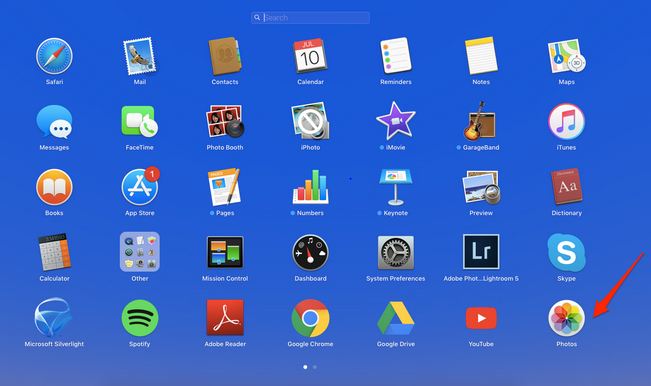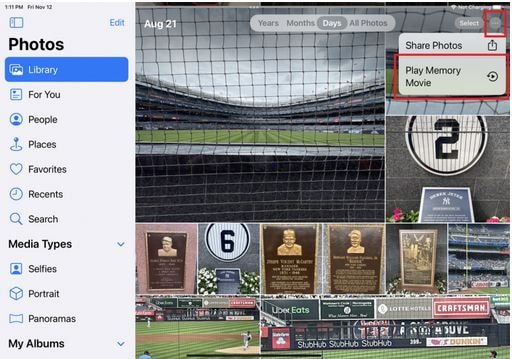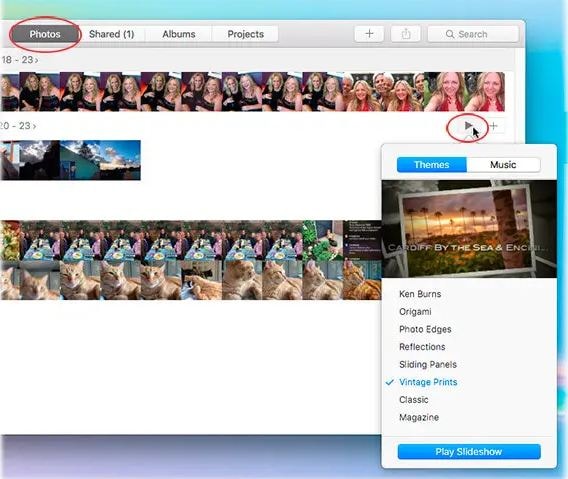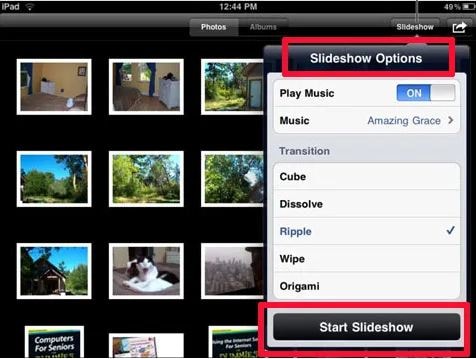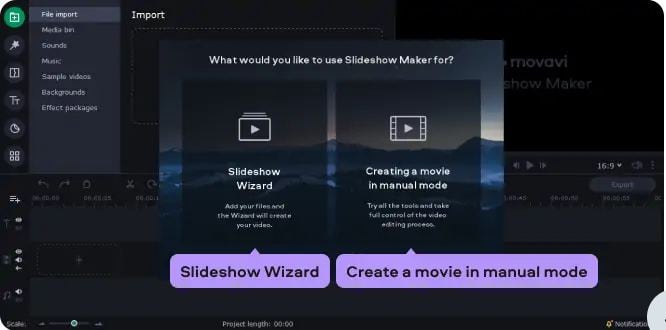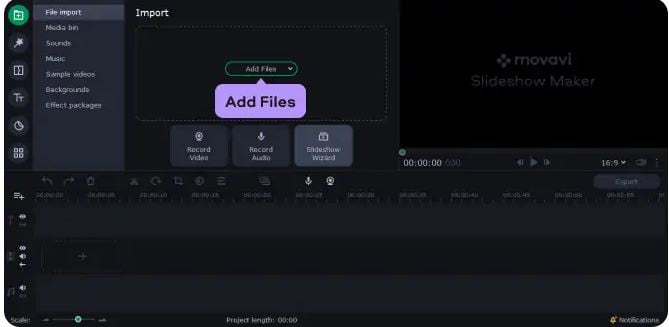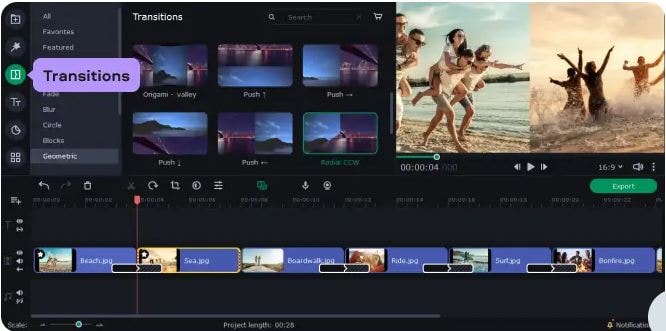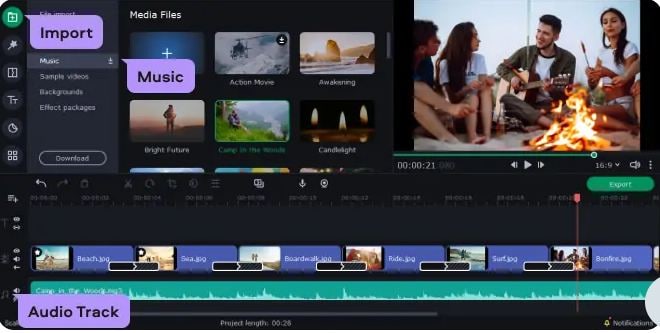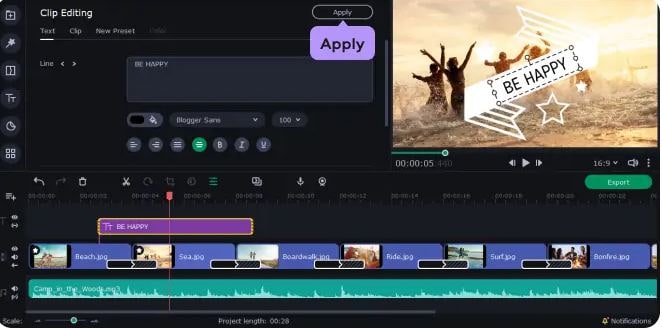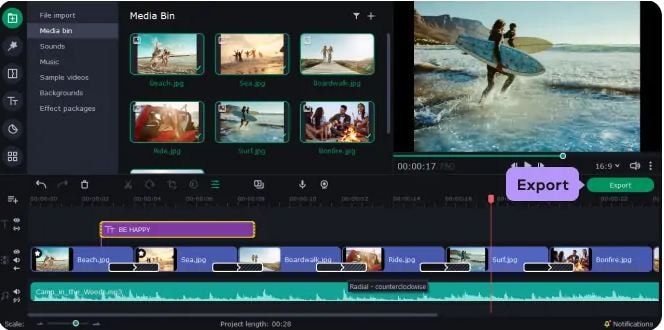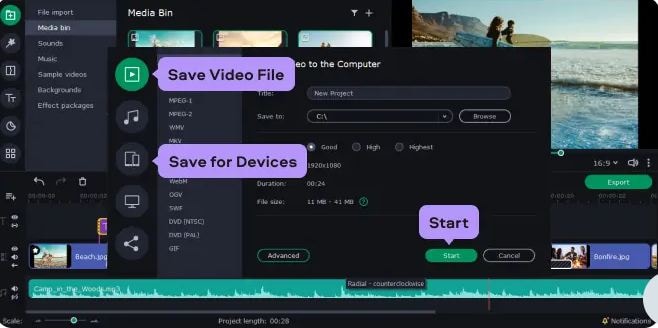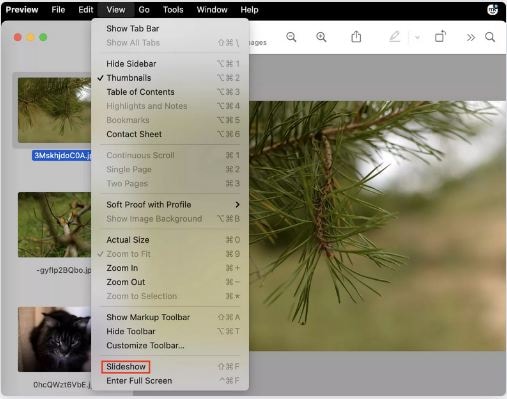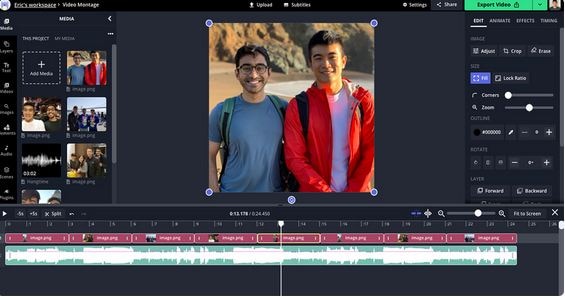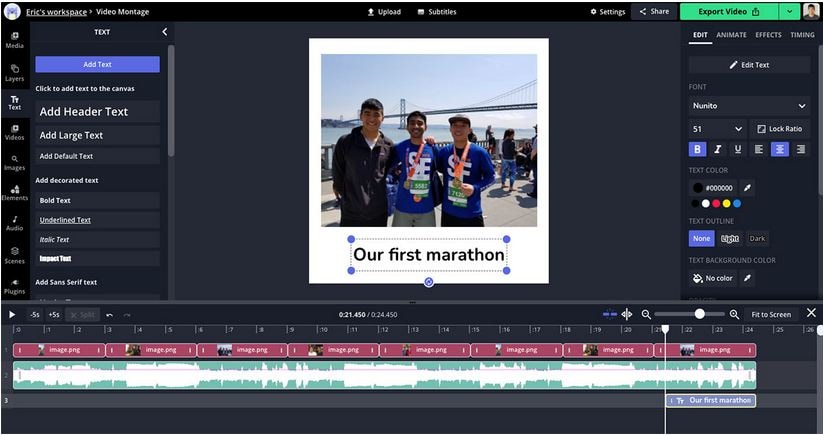
How To Make Ninja Jump Effect

How To Make Ninja Jump Effect
Superpower scenes derived from movies are trending these days. Everyone wants to add these superpower effects to their clips. We have covered several of these tutorials, and here we are with a new one; the Super/Ninja Jump effect.
This effect is for the quick movement of a subject from one position to another. Naruto is the prime example where ninjas are made to move around by this effect. Anime creators use this ninja effect a lot.
This article includes tutorials on what to shoot and how to add the Super Jump effect using Wondershare Filmora . The use of tools like masking, time ramping, keyframing, and the new version addition, the Boris FX Pack, makes it super easy to get a perfect super jump effect.
Shots Required For Super Jump Effect
You can use either a mobile phone or a camera for shooting, but you have to keep these things in mind:
Keep the following important tips in mind while shooting clips using your phone or camera.
● Use Wide-Angle
Always use the wide-angle view to ensure everything is in focus with a good depth of field.
● The Camera Should Be Steady
Make sure that the phone or camera is on a steady surface to avoid any turbulence or frame shifting.
● Sufficient Light
Make sure there is sufficient light and ambiance. Once you have set your camera, these are the three shots you have to take:
Shot 1: Jump Into the Air at a Distance
The subject will jump into the air at a distance from the camera. He should jump as high as he can, folding his legs so his body is in a ball position while in the air. The distance should be proper—not very far away.
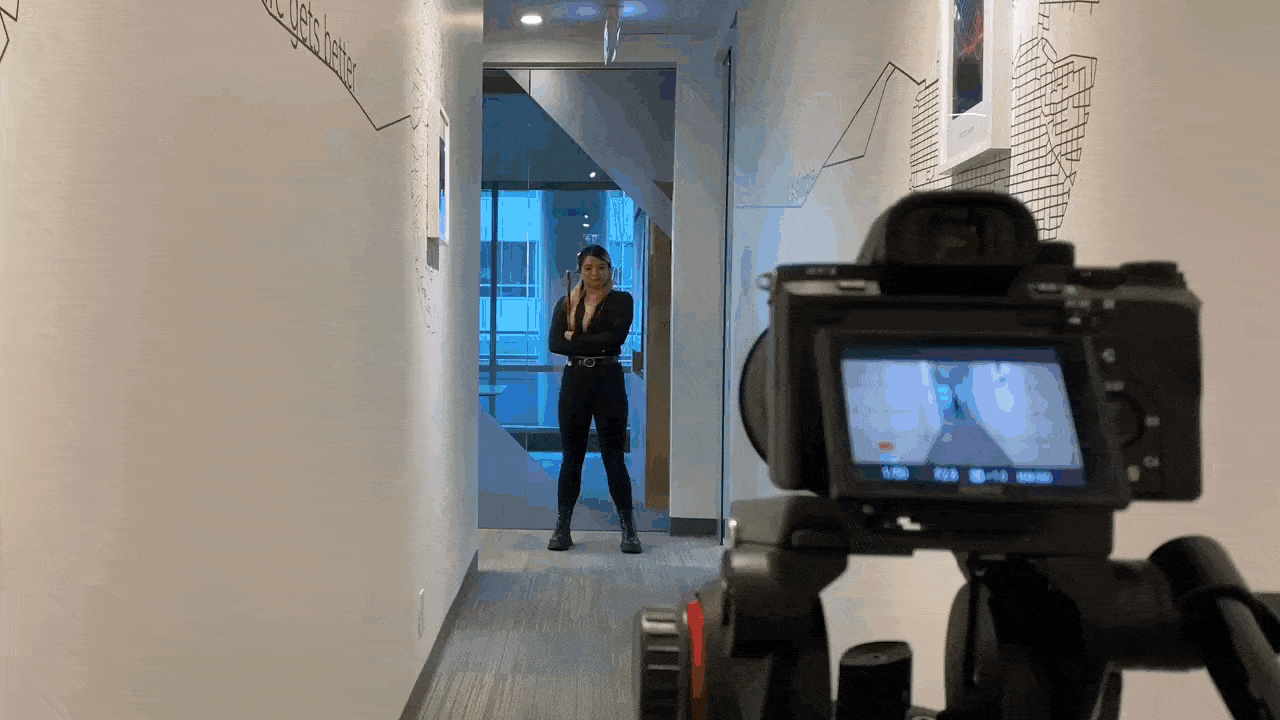
Shot 2: Jump and Act Like You Are Landing
The subject should jump and act like he is landing on the floor. This shot has to be taken directly in front of the camera.

Shot 3: Empty Background Clip
This is an empty background clip. This clip includes only background settings without the subject. We need this clip to make layers while editing.
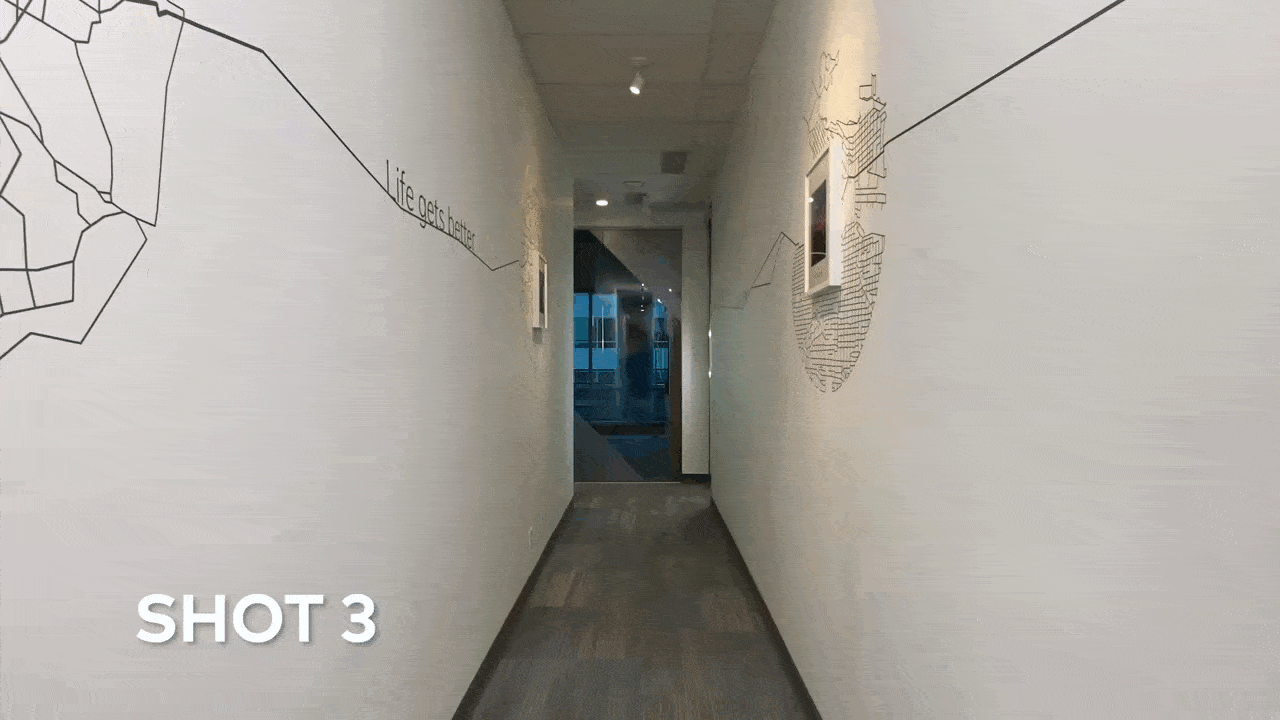
How To Edit These Clips On Filmora?
Once the shots have been taken, we move towards editing these clips, and for this purpose, we are using Filmora. Here is a step-by-step guide for editing these shots.
Steps To Edit These Clips
The tools we are going to use in this editing are masking, time ramping, speed ramping, keyframing, the Boris FX effect, and many more.
Open Wondershare Filmora and Add Video Tracks
Steps
Step1 Select the empty background clip (shot 3) and place it on the first video track timeline.
Step2 Now place the jumping clip (shot 4) on the top.
Adding a Freeze Frame
A freeze frame is a type of still image that is created by simply freezing the action. Most of the time, this is used in the last shot of a movie to capture a moment in time. Here are the steps to adding a free frame.
Steps
Step1 Move the playhead up to the point where the subject’s body appears smallest.
Step2 Add a freeze frame at this point by right-clicking on the playhead and selecting the speed option.
Step3 Make a cut at the start of the freeze frame, keep it for 8 frames and delete the rest.
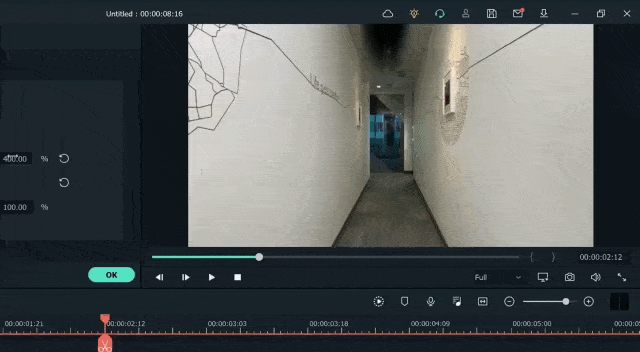
Masking of the Video Clips
Masking is a tool in editing software that allows you to hide, duplicate, show, or adjust footage by selecting a specific section of the video or using video overlays. The steps for adding the masking effect are given below:
Steps
Step1 Now click on the clip view to open the “settings” window.
Step2 Click on the “mask” section and select the circle mask and create the mask of the jumping subject.
Step3 Hide the first track clip so that mask can be viewed better and edited effectively.
Step4 Adjust the scale, position, and shape of the mask and make the edges smoother to match the object.
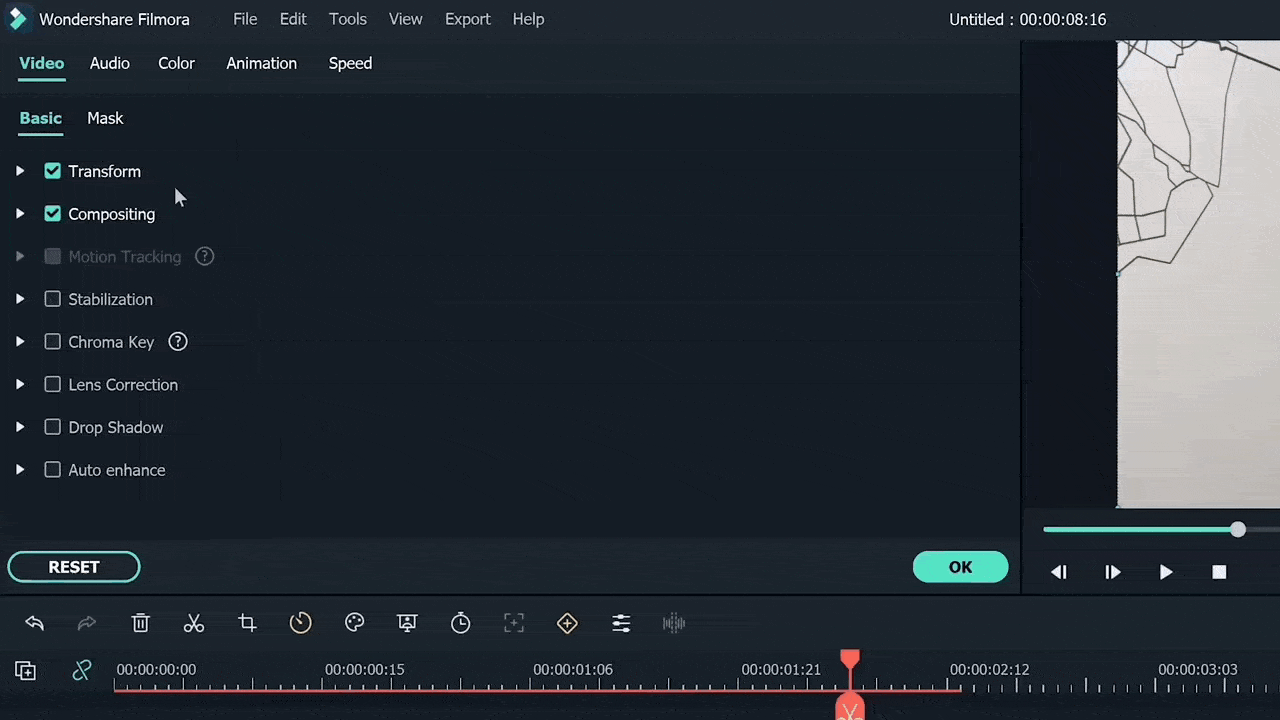
Boris Fx Effect
Boris FX is a video editing and visual effects software. Filmora supports six continuum units-professional quality effects plugins from award-winning developer Boris FX.
To add these effects to your videos, follow the steps below:
Steps
Step1 Go to the “effects” window and open the Boris FX effects.
Step2 Select the directional blur from the bcc blur category.
Step3 Drag the effect to the freeze frame.
Step4 Now clicking on freeze frame, its settings will open.
Step5 Adjust the degree and angle of blur to get a perfect mask object. Turn ON the first video track.
Step6 Add the landing clip (shot 2) on top of the first video track after the freezing frame.
Step7 Find the point where the subject starts to descend toward the floor. Cut the clip here and delete the previous part.
Step8 Move the clip next to the freeze frame clip.

Keyframing
Now we have to add animation in the freezing frame so that the masked shadow can be shown moving from the back towards the front, a speedy moving shadow. This is probably the most crucial step in editing.
Steps
Step1 Click on the freezing frame, and in the settings window, open “animation.”
Step2 Click on the customized option. Add the first keyframe at the start of the clip.
Step3 Now move two frames and add another keyframe with the position of the masked shadow as it is moving out of frame.
Step4 Now move two frames keeping the settings the same.
Step5 Add another keyframe at the end with your masked shadow appearing half from the top of the frame.
This step is a bit tricky to understand, but the most important. Once it is done, your animation will give the impression of an object moving like a flash from the back to the front of view.
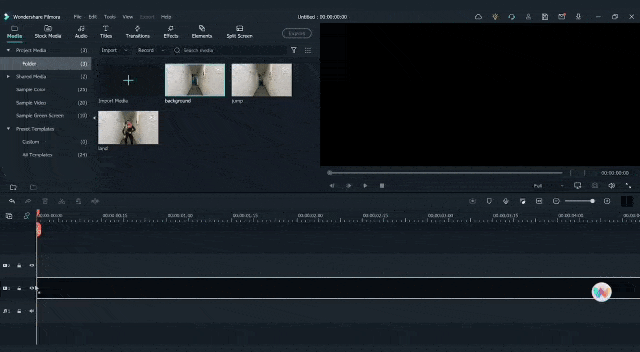
Speed Ramping
Once the keyframing is done, your super jump effect is roughly ready. All you have to do now is synchronize the speed of jumping, moving shadow, and landing. Here we will use the “speed ramping” tool.
Steps
Step1 Click on the clip, and in the settings window, choose “speed.”
Step2 Click on customize and increase the speed of any frame or clip.
Step3 Move the play head on the frame that you intend to increase the speed of, and move the frame on the speed window to speed up that part.
Once you have done speed ramping on both clips, your editing is done. Now play the video and see how the clip looks and if your super jump effect is remarkable or not.
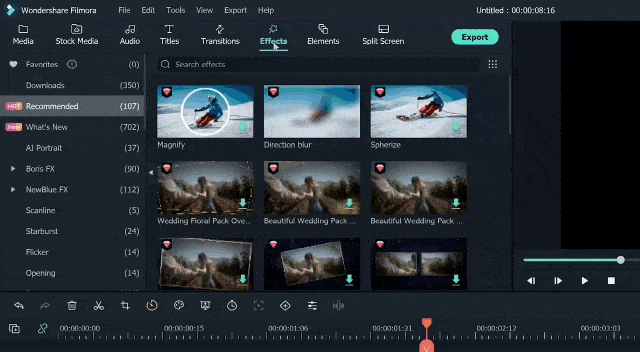
Final Words
Make sure you follow all these steps in the correct order. You can get Filmora from the Filmora website, but its cracked versions are also available. While editing, try to make the transitions and clips as smooth and synchronized as you can. Also, if you find this article helpful, do not forget to share these tips with your friends.
Free Download For Win 7 or later(64-bit)
Free Download For macOS 10.14 or later
Free Download For macOS 10.14 or later
OBS Studio Is a Free and Open-Source App for Screen-Casting and Live Streaming
OBS Studio is a free and open-source app for screen-casting and live streaming. Written in C/C++ and built with Qt, OBS Studio provides real-time capture, scene composition, recording, encoding, and broadcasting via the Real Time Messaging Protocol (RTMP).It can stream Videos to any RTMP supporting destination including YouTube, Twitch, Instagram and Facebook.
You only need one green screen software – OBS. The reason why OBS is the most recommended for streaming is because once you have set it up properly, you can do literally anything you can think of with the software (either with or without added plug-ins).
Chroma Key Settings in OBS
Chroma keying has become incredibly popular nowadays. People use it not just for gaming, but also in Zoom conferences, live interviews, talk shows, etc. Although it may feel complicated at first glance, setting up Chroma Key in OBS Studio is actually incredibly easy.
Have a look at the simple steps you need to take to set up a green screen in OBS:
- Make sure you have the following equipment prepared: a solid green background, webcam or video camera, lighting, and OBS Studio.
- Download the latest stable version of OBS Studio from the official website and install the software. Open OBS and let the Auto-Configuration Wizard optimize the software’s settings based on your hardware.
- Now you can add a video source.
- Right-click on the video source you’ve created and select Filter.
- Click the + button under the Effects Filters section and select Chroma Key.
- Type in a name for this effect layer.
- After you add a chroma key, OBS will automatically create and adjust the baseline settings for the filter. You can experiment with the sliders and settle when you are satisfied with the result.
- Make sure you aren’t wearing any green or reflective material. You can double-check the performance on the preview screen.
- If things are working smoothly, you are all set to start streaming with the green screen on.
Pro tip:
You can follow the instructions above and live stream to multiple platforms at once with Restream. Multistreaming to platforms like YouTube, Facebook, Twitter, Twitch, and LinkedIn allows you to drastically increase the audience reach and grow your followers.
How to make OBS green screen settings better
Using green screens for filmmaking isn’t the most complicated or difficult thing in the world but it certainly has its pitfalls. If you ask any experienced filmmaker what to look out for when using a green screen, chances are they’re going to mention lighting about a billion times and that’s for good reason.
Tips on How to make OBS green screen settings better
- Evenly light your green screen so you can get a good key.
- Watch out for light flares. Use some a matte box or your trusty paw to block out any unwanted light.
- When lighting, try to create as much separation between your subject and the green screen as you can.
- Shutter speed: Minimize motion blur by raising your shutter speed to 1/80 or 1/100
- Aperture: Setting your aperture to f4 or f5.6 will give you slightly more depth of field, which will blur and smooth out your green screen.
- Format: Set your camera to the best recording format it has.
- ISO: Try to avoid high ISOs.
Filmora
If you’re just starting out with video editing, or just want a simple program that works, Wondershare Filmora might be what you’re looking for. It has the essential tools, and anyone can learn to use it easily.
Wondershare Filmora is the one of best video editing software with cool features that compares to other competing video editing Softwares. Many video editing programs claim to offer professional results; Filmora is one of a few consumer-level tools that actually delivers.
For Win 7 or later (64-bit)
For macOS 10.12 or later
Installation Steps
- Click the icon in the center of the Media Library to add files directly.
- Go File > Import Media > Import Media Files.
- Drag and drop to the Media Library directly.
While importing a media file, Wondershar Filmora may ask you if you wish to create a proxy file to accelerate the editing process. Select “Yes” to have a fast video editing experience.
You can also import video clips using your Touch Bar controls if your computer has Touch Bar.

Record a media file
Apart from the videos shot by your digital devices, you can also directly import media files by recording video from your webcam, capturing the computer screen, or recording a voice-over.
Record computer screen:
Click the “Record” option, and choose “Record PC Screen” to get the built-in Wondershare Screen Recorder. Hit the red button to get started. If you want to stop the recording, you can hit F9.
Record videos from webcam:
Also, click the “Record” option, and choose “Record from Webcam”. In the pop-up Video Recording window, click the red button to start recording and click it again to stop recording. Then click OK to save the recorded video file.
Record voice-over:
Choose “Record a voiceover” under the Record menu. It would be better to connect a microphone to your Mac for a better result. Hit the Record button, and it leaves you 3 seconds to get ready.
All the recorded media files will be saved into Media Library automatically and you can drag them to the Timeline for editing.
Pro tip:
You can follow the instructions above and live stream to multiple platforms at once with Restream. Multistreaming to platforms like YouTube, Facebook, Twitter, Twitch, and LinkedIn allows you to drastically increase the audience reach and grow your followers.
How to make OBS green screen settings better
Using green screens for filmmaking isn’t the most complicated or difficult thing in the world but it certainly has its pitfalls. If you ask any experienced filmmaker what to look out for when using a green screen, chances are they’re going to mention lighting about a billion times and that’s for good reason.
Tips on How to make OBS green screen settings better
- Evenly light your green screen so you can get a good key.
- Watch out for light flares. Use some a matte box or your trusty paw to block out any unwanted light.
- When lighting, try to create as much separation between your subject and the green screen as you can.
- Shutter speed: Minimize motion blur by raising your shutter speed to 1/80 or 1/100
- Aperture: Setting your aperture to f4 or f5.6 will give you slightly more depth of field, which will blur and smooth out your green screen.
- Format: Set your camera to the best recording format it has.
- ISO: Try to avoid high ISOs.
Filmora
If you’re just starting out with video editing, or just want a simple program that works, Wondershare Filmora might be what you’re looking for. It has the essential tools, and anyone can learn to use it easily.
Wondershare Filmora is the one of best video editing software with cool features that compares to other competing video editing Softwares. Many video editing programs claim to offer professional results; Filmora is one of a few consumer-level tools that actually delivers.
For Win 7 or later (64-bit)
For macOS 10.12 or later
Installation Steps
- Click the icon in the center of the Media Library to add files directly.
- Go File > Import Media > Import Media Files.
- Drag and drop to the Media Library directly.
While importing a media file, Wondershar Filmora may ask you if you wish to create a proxy file to accelerate the editing process. Select “Yes” to have a fast video editing experience.
You can also import video clips using your Touch Bar controls if your computer has Touch Bar.

Record a media file
Apart from the videos shot by your digital devices, you can also directly import media files by recording video from your webcam, capturing the computer screen, or recording a voice-over.
Record computer screen:
Click the “Record” option, and choose “Record PC Screen” to get the built-in Wondershare Screen Recorder. Hit the red button to get started. If you want to stop the recording, you can hit F9.
Record videos from webcam:
Also, click the “Record” option, and choose “Record from Webcam”. In the pop-up Video Recording window, click the red button to start recording and click it again to stop recording. Then click OK to save the recorded video file.
Record voice-over:
Choose “Record a voiceover” under the Record menu. It would be better to connect a microphone to your Mac for a better result. Hit the Record button, and it leaves you 3 seconds to get ready.
All the recorded media files will be saved into Media Library automatically and you can drag them to the Timeline for editing.
Pro tip:
You can follow the instructions above and live stream to multiple platforms at once with Restream. Multistreaming to platforms like YouTube, Facebook, Twitter, Twitch, and LinkedIn allows you to drastically increase the audience reach and grow your followers.
How to make OBS green screen settings better
Using green screens for filmmaking isn’t the most complicated or difficult thing in the world but it certainly has its pitfalls. If you ask any experienced filmmaker what to look out for when using a green screen, chances are they’re going to mention lighting about a billion times and that’s for good reason.
Tips on How to make OBS green screen settings better
- Evenly light your green screen so you can get a good key.
- Watch out for light flares. Use some a matte box or your trusty paw to block out any unwanted light.
- When lighting, try to create as much separation between your subject and the green screen as you can.
- Shutter speed: Minimize motion blur by raising your shutter speed to 1/80 or 1/100
- Aperture: Setting your aperture to f4 or f5.6 will give you slightly more depth of field, which will blur and smooth out your green screen.
- Format: Set your camera to the best recording format it has.
- ISO: Try to avoid high ISOs.
Filmora
If you’re just starting out with video editing, or just want a simple program that works, Wondershare Filmora might be what you’re looking for. It has the essential tools, and anyone can learn to use it easily.
Wondershare Filmora is the one of best video editing software with cool features that compares to other competing video editing Softwares. Many video editing programs claim to offer professional results; Filmora is one of a few consumer-level tools that actually delivers.
For Win 7 or later (64-bit)
For macOS 10.12 or later
Installation Steps
- Click the icon in the center of the Media Library to add files directly.
- Go File > Import Media > Import Media Files.
- Drag and drop to the Media Library directly.
While importing a media file, Wondershar Filmora may ask you if you wish to create a proxy file to accelerate the editing process. Select “Yes” to have a fast video editing experience.
You can also import video clips using your Touch Bar controls if your computer has Touch Bar.

Record a media file
Apart from the videos shot by your digital devices, you can also directly import media files by recording video from your webcam, capturing the computer screen, or recording a voice-over.
Record computer screen:
Click the “Record” option, and choose “Record PC Screen” to get the built-in Wondershare Screen Recorder. Hit the red button to get started. If you want to stop the recording, you can hit F9.
Record videos from webcam:
Also, click the “Record” option, and choose “Record from Webcam”. In the pop-up Video Recording window, click the red button to start recording and click it again to stop recording. Then click OK to save the recorded video file.
Record voice-over:
Choose “Record a voiceover” under the Record menu. It would be better to connect a microphone to your Mac for a better result. Hit the Record button, and it leaves you 3 seconds to get ready.
All the recorded media files will be saved into Media Library automatically and you can drag them to the Timeline for editing.
Pro tip:
You can follow the instructions above and live stream to multiple platforms at once with Restream. Multistreaming to platforms like YouTube, Facebook, Twitter, Twitch, and LinkedIn allows you to drastically increase the audience reach and grow your followers.
How to make OBS green screen settings better
Using green screens for filmmaking isn’t the most complicated or difficult thing in the world but it certainly has its pitfalls. If you ask any experienced filmmaker what to look out for when using a green screen, chances are they’re going to mention lighting about a billion times and that’s for good reason.
Tips on How to make OBS green screen settings better
- Evenly light your green screen so you can get a good key.
- Watch out for light flares. Use some a matte box or your trusty paw to block out any unwanted light.
- When lighting, try to create as much separation between your subject and the green screen as you can.
- Shutter speed: Minimize motion blur by raising your shutter speed to 1/80 or 1/100
- Aperture: Setting your aperture to f4 or f5.6 will give you slightly more depth of field, which will blur and smooth out your green screen.
- Format: Set your camera to the best recording format it has.
- ISO: Try to avoid high ISOs.
Filmora
If you’re just starting out with video editing, or just want a simple program that works, Wondershare Filmora might be what you’re looking for. It has the essential tools, and anyone can learn to use it easily.
Wondershare Filmora is the one of best video editing software with cool features that compares to other competing video editing Softwares. Many video editing programs claim to offer professional results; Filmora is one of a few consumer-level tools that actually delivers.
For Win 7 or later (64-bit)
For macOS 10.12 or later
Installation Steps
- Click the icon in the center of the Media Library to add files directly.
- Go File > Import Media > Import Media Files.
- Drag and drop to the Media Library directly.
While importing a media file, Wondershar Filmora may ask you if you wish to create a proxy file to accelerate the editing process. Select “Yes” to have a fast video editing experience.
You can also import video clips using your Touch Bar controls if your computer has Touch Bar.

Record a media file
Apart from the videos shot by your digital devices, you can also directly import media files by recording video from your webcam, capturing the computer screen, or recording a voice-over.
Record computer screen:
Click the “Record” option, and choose “Record PC Screen” to get the built-in Wondershare Screen Recorder. Hit the red button to get started. If you want to stop the recording, you can hit F9.
Record videos from webcam:
Also, click the “Record” option, and choose “Record from Webcam”. In the pop-up Video Recording window, click the red button to start recording and click it again to stop recording. Then click OK to save the recorded video file.
Record voice-over:
Choose “Record a voiceover” under the Record menu. It would be better to connect a microphone to your Mac for a better result. Hit the Record button, and it leaves you 3 seconds to get ready.
All the recorded media files will be saved into Media Library automatically and you can drag them to the Timeline for editing.
How to Make a Gaming Montage - Guide & Tips
The popularity of gaming montage is growing every day in today’s pop culture. There are currently more than 2.5 billion gamers, and most of them love watching gaming video content on YouTube. Whether people use a montage to parody gaming montages themselves or show off their skills, the effort and time put into them create impressive results.
We will explain how to create gaming montages and give you some tips that you might want to keep in mind to make epic videos.
How to Make a Gaming Montage
You have several options when it comes to creating gaming montages. You can include a random cut of great scenes, a mixture of the highlighted moments you found thrilling and would like to share with other gamers. In other cases, you’ll have to think of an engaging story in advance, then base your gameplay on this story.
Essentially, the workflow will be slightly different for these two scenarios. It’s much easier with the random cut type, especially when using a reliable video editor. Editing montages is as exciting as playing the game.
With that in mind, here is how to make a gaming montage.
1) Decide Your Montage Story/Type
Deciding your montage type beforehand helps clear your mind and create an epic gaming montage that will keep viewers watching. It allows you to choose the relevant video clips for your gaming montage.
Choose the topic of the video and decide the length of each clip and the sequence of the clips. Be sure to put the most epic or funny clips in the last section of your video. And this will make your viewers watch the video until the end.
2) Record Your Gameplay Footage
The methods to capture the gameplay varies depending on the platform where the game is. The most important thing you have to keep in mind is to ensure your recorder supports Replay Buffer; this will allow you to record scenes that occurred minutes or seconds ago.
That means you do not need to record the gameplay the whole time and burn your hardware. Instead, you’ll capture the moment after interesting things occur.
Game consoles like PS4 allow you to record the video natively for a maximum of one hour with the gamepad. A capture card lets you record it longer than 60 minutes.
Once you’ve all the clips you want on your PC, head over to https://filmora.wondershare.net/filmora-video-editor.html and download Filmora and install the software on your computer. This program allows you to edit your video clips and add cool effects that will make viewers keep watching.
3) Import You Videos to Media Library
You only have to import the videos to Filmora’s media library and then drag and drop them into the timeline, where you can start making the edits.
By right-clicking on the clip in your timeline, you’ll see the options to zoom, speed, change, split, or trim your videos. You can also add sound effects by going to the Audio Tab.
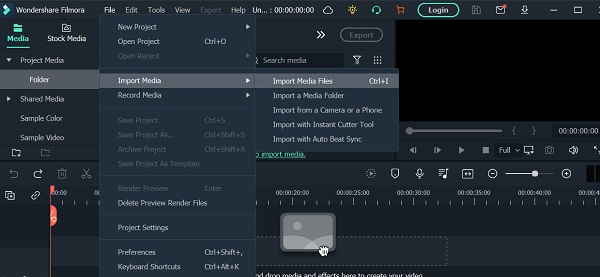
Import Videos
4) Choose Background Music for Your Montage
Music will help make your gaming montage engaging. Make sure you use a license-free track if you plan to post it on social media.
Using copyrighted music tracks and uploading the video on social media platforms can lead to video strikes. Luckily, Filmora has loads of non-copyrighted music tracks.
Navigate to Stock Media, where you’ll find non-copyrighted music on Pixabay, and choose the one you prefer.

Choose Background Music
5) Edit the Gaming Montage
With Filmora’s auto gaming montage maker, you can watch the video clip with the music you have selected. This tool will analyze beat points to change the video and effects.
Additionally, the tool can identify any bad parts in your video and delete them so that the video matches the music.
The Effects tab allows you to add multiple overlays and filters to your gaming montage video. Filmora has different categories of overlays that let you add emotions or personality to your montage. You can also use it to set the tone in your video.
Filters allow you to spice up your gaming videos. There are also different types of filters on Filmora.
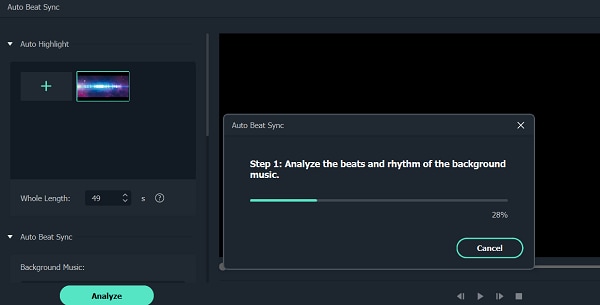
Edit Gaming Montage
6) Export Your Gaming Montage Video
Once you have finished editing your video and added music, hit the Export button. Doing this will allow you to export your edited video and save it on your computer.
You can now enter your login details and upload your gaming montage video on your YouTube channel to share it with other players.
Useful Tips for Making a Gaming Montage
Making gaming montages can help you build a large online community if you do the right thing. When making a gaming montage, there are a few tips that you should keep in mind. They include:
1. Apply Velocity Effects
Adding velocity effects to your montage will help get the attention of viewers. You can couple the transition between scenes with a speed ramping effect.
Include slow motion where there is a gunshot or other big gaming moment. You can then speed up things to quickly move into another scene. You can create these velocity effects in Filmora and make it smooth.
2. Avoid Game Loading Scenes
Do not include game loading scenes or any unnecessary clips in the gaming montage. Your audience does not have the time to wait for the scenes to load because they want to see action fast.
3. Sync Gunshot with Music Beat
Try to match gunshot sounds with beats and rhythms in shooter video games. The beats of the music and the soothing sync of gunshots will catch viewers’ attention and your video will become popular among gamers.
4. Add Creative Transitions
You can spice up your gaming montage by adding transitions, especially when you have loads of clips for the montage. But avoid overusing it, as you could confuse your audience with a range of dazzling and glaring transitions.
5. Color Grade the Video for the Mood
Use color grading to your advantage, as it can set the mood of your viewers. You can decide to make some scenes black and white to catch the viewers’ attention.
6. Add Video Vignettes for Special Occasions
You can add dark edges around the corners of your video to highlight action or create a certain mood. For gameplay based on a story, use vignetting to add a sense of nostalgia or as a flashback that shows viewers the past.
You can use Filmora to apply the vignetting effect by heading to Advanced Color Tuning, then clicking the Vignette option. You can then add the vignette effect to the video. Additionally, you can adjust the vignette’s exposure, feather, roundness, size, and highlights.
Best Gaming Montage for Studying
Here are three gaming montages that are good for studying.
1. Call of Duty: Modern Warfare
Uploaded by DemixB, the Call of Duty Game Montage uses Jacques Offenbach’s Can Can Music track. It’s a happy song that has a tempo of 81 BPM. The track has average danceable energy, and it’s somewhat danceable.
DemixB set the gunshot in the montage video to the music tune. The track builds up to the climax when the gunshot echoes with the attention-grabbing orchestral explosions.

Call of Duty: Modern Warfare
2. ShutteR’s Gaming Montage
In the gaming montage uploaded by ShutteR on his YouTube channel, he used velocity effects to enhance the video. You’ll see that the transition in each scene is paired with adrenaline-pumping, speed-ramping effects.
ShutteR used a slow-motion to highlight action in each scene, then speeds up again when he wants to fast out into the next scene.; this makes the video more engaging to keep viewers glued to their screens.
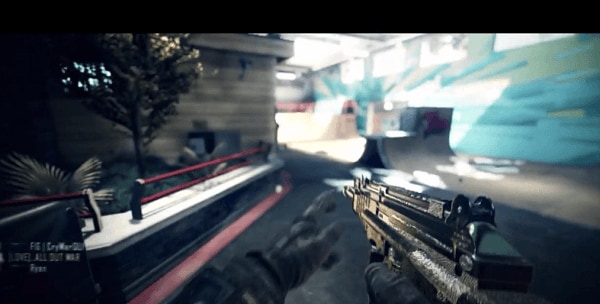
ShutteR’s Gaming Montage
3. NEVERMORE [CS: GO]
NEVERMORE [CS: GO] was uploaded by Fuze on his YouTube channel, and it has creative gameplay. The gaming montage is based on a story. He did the project with Apel, an artist who designed the Fever Dream series skins in the video.
The basic idea of this gaming montage was that the main game character is a corrupted policeman with purple glowing eyes because he’s not human.
When the edits begin, the shape of the main character will shift from CS: GO CT models and turn into his real corrupt CT shape. So that’s why his name keeps changing. You can get his real identity by pausing some of the frames and looking at the “Killfeed.”
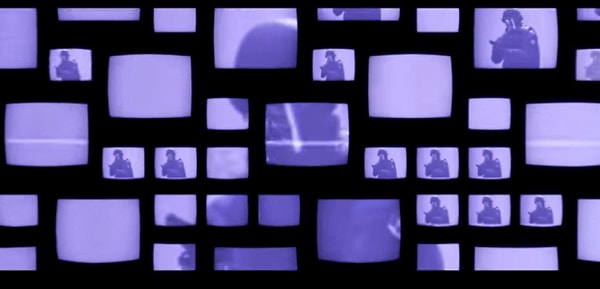
NEVERMORE [CS: GO]
Closing Thoughts:
Gaming montage involves picking and editing a range of video clips, which are brought together to create engaging video content. It consists of the best scenes from gameplay and non-copyrighted background music.
Use Filmora to edit and add effects to your video, including transitions and overlays. Your gaming montage will get more views, hence becoming popular among players.
The popularity of gaming montage is growing every day in today’s pop culture. There are currently more than 2.5 billion gamers, and most of them love watching gaming video content on YouTube. Whether people use a montage to parody gaming montages themselves or show off their skills, the effort and time put into them create impressive results.
We will explain how to create gaming montages and give you some tips that you might want to keep in mind to make epic videos.
How to Make a Gaming Montage
You have several options when it comes to creating gaming montages. You can include a random cut of great scenes, a mixture of the highlighted moments you found thrilling and would like to share with other gamers. In other cases, you’ll have to think of an engaging story in advance, then base your gameplay on this story.
Essentially, the workflow will be slightly different for these two scenarios. It’s much easier with the random cut type, especially when using a reliable video editor. Editing montages is as exciting as playing the game.
With that in mind, here is how to make a gaming montage.
1) Decide Your Montage Story/Type
Deciding your montage type beforehand helps clear your mind and create an epic gaming montage that will keep viewers watching. It allows you to choose the relevant video clips for your gaming montage.
Choose the topic of the video and decide the length of each clip and the sequence of the clips. Be sure to put the most epic or funny clips in the last section of your video. And this will make your viewers watch the video until the end.
2) Record Your Gameplay Footage
The methods to capture the gameplay varies depending on the platform where the game is. The most important thing you have to keep in mind is to ensure your recorder supports Replay Buffer; this will allow you to record scenes that occurred minutes or seconds ago.
That means you do not need to record the gameplay the whole time and burn your hardware. Instead, you’ll capture the moment after interesting things occur.
Game consoles like PS4 allow you to record the video natively for a maximum of one hour with the gamepad. A capture card lets you record it longer than 60 minutes.
Once you’ve all the clips you want on your PC, head over to https://filmora.wondershare.net/filmora-video-editor.html and download Filmora and install the software on your computer. This program allows you to edit your video clips and add cool effects that will make viewers keep watching.
3) Import You Videos to Media Library
You only have to import the videos to Filmora’s media library and then drag and drop them into the timeline, where you can start making the edits.
By right-clicking on the clip in your timeline, you’ll see the options to zoom, speed, change, split, or trim your videos. You can also add sound effects by going to the Audio Tab.

Import Videos
4) Choose Background Music for Your Montage
Music will help make your gaming montage engaging. Make sure you use a license-free track if you plan to post it on social media.
Using copyrighted music tracks and uploading the video on social media platforms can lead to video strikes. Luckily, Filmora has loads of non-copyrighted music tracks.
Navigate to Stock Media, where you’ll find non-copyrighted music on Pixabay, and choose the one you prefer.

Choose Background Music
5) Edit the Gaming Montage
With Filmora’s auto gaming montage maker, you can watch the video clip with the music you have selected. This tool will analyze beat points to change the video and effects.
Additionally, the tool can identify any bad parts in your video and delete them so that the video matches the music.
The Effects tab allows you to add multiple overlays and filters to your gaming montage video. Filmora has different categories of overlays that let you add emotions or personality to your montage. You can also use it to set the tone in your video.
Filters allow you to spice up your gaming videos. There are also different types of filters on Filmora.

Edit Gaming Montage
6) Export Your Gaming Montage Video
Once you have finished editing your video and added music, hit the Export button. Doing this will allow you to export your edited video and save it on your computer.
You can now enter your login details and upload your gaming montage video on your YouTube channel to share it with other players.
Useful Tips for Making a Gaming Montage
Making gaming montages can help you build a large online community if you do the right thing. When making a gaming montage, there are a few tips that you should keep in mind. They include:
1. Apply Velocity Effects
Adding velocity effects to your montage will help get the attention of viewers. You can couple the transition between scenes with a speed ramping effect.
Include slow motion where there is a gunshot or other big gaming moment. You can then speed up things to quickly move into another scene. You can create these velocity effects in Filmora and make it smooth.
2. Avoid Game Loading Scenes
Do not include game loading scenes or any unnecessary clips in the gaming montage. Your audience does not have the time to wait for the scenes to load because they want to see action fast.
3. Sync Gunshot with Music Beat
Try to match gunshot sounds with beats and rhythms in shooter video games. The beats of the music and the soothing sync of gunshots will catch viewers’ attention and your video will become popular among gamers.
4. Add Creative Transitions
You can spice up your gaming montage by adding transitions, especially when you have loads of clips for the montage. But avoid overusing it, as you could confuse your audience with a range of dazzling and glaring transitions.
5. Color Grade the Video for the Mood
Use color grading to your advantage, as it can set the mood of your viewers. You can decide to make some scenes black and white to catch the viewers’ attention.
6. Add Video Vignettes for Special Occasions
You can add dark edges around the corners of your video to highlight action or create a certain mood. For gameplay based on a story, use vignetting to add a sense of nostalgia or as a flashback that shows viewers the past.
You can use Filmora to apply the vignetting effect by heading to Advanced Color Tuning, then clicking the Vignette option. You can then add the vignette effect to the video. Additionally, you can adjust the vignette’s exposure, feather, roundness, size, and highlights.
Best Gaming Montage for Studying
Here are three gaming montages that are good for studying.
1. Call of Duty: Modern Warfare
Uploaded by DemixB, the Call of Duty Game Montage uses Jacques Offenbach’s Can Can Music track. It’s a happy song that has a tempo of 81 BPM. The track has average danceable energy, and it’s somewhat danceable.
DemixB set the gunshot in the montage video to the music tune. The track builds up to the climax when the gunshot echoes with the attention-grabbing orchestral explosions.

Call of Duty: Modern Warfare
2. ShutteR’s Gaming Montage
In the gaming montage uploaded by ShutteR on his YouTube channel, he used velocity effects to enhance the video. You’ll see that the transition in each scene is paired with adrenaline-pumping, speed-ramping effects.
ShutteR used a slow-motion to highlight action in each scene, then speeds up again when he wants to fast out into the next scene.; this makes the video more engaging to keep viewers glued to their screens.

ShutteR’s Gaming Montage
3. NEVERMORE [CS: GO]
NEVERMORE [CS: GO] was uploaded by Fuze on his YouTube channel, and it has creative gameplay. The gaming montage is based on a story. He did the project with Apel, an artist who designed the Fever Dream series skins in the video.
The basic idea of this gaming montage was that the main game character is a corrupted policeman with purple glowing eyes because he’s not human.
When the edits begin, the shape of the main character will shift from CS: GO CT models and turn into his real corrupt CT shape. So that’s why his name keeps changing. You can get his real identity by pausing some of the frames and looking at the “Killfeed.”

NEVERMORE [CS: GO]
Closing Thoughts:
Gaming montage involves picking and editing a range of video clips, which are brought together to create engaging video content. It consists of the best scenes from gameplay and non-copyrighted background music.
Use Filmora to edit and add effects to your video, including transitions and overlays. Your gaming montage will get more views, hence becoming popular among players.
How to Create an Instant Slideshow on Mac
How to Create an Instant Slideshow on Mac
An easy yet powerful editor
Numerous effects to choose from
Detailed tutorials provided by the official channel
Instant slideshows on Mac devices are elusive graphic elements to creatively convey your information to the target audience. Stay here to have a complete knowhow of the design process!
In this article
01 [How to Create a Slideshow in Photos on Mac](#Part 1)
02 [How to Create a Slideshow in Video on Mac](#Part 2)
03 [How to Make a Slideshow on Mac in Preview](#Part 3)
04 [How to Create Slideshows Online](#Part 4)
05 [FAQs About Slideshows on Mac](#Part 5)
Part 1 How to Create a Slideshow in Photos on Mac
Creating a slideshow is an intuitive exploration of your graphic design skills, either just for a fun-filled entertainment, or catering to some specific information delivery on the professional front. When aiming to create Mac photos slideshow presentations, you can affordably pick any of your preferred devices and a suitable slideshow creator tool.
Speaking in the light of the fact, it is an equally amazing experience to design exemplary movies and presentations for a slide show MacBook, thanks to the high end technical abilities of such devices that work together to facilitate a remarkable and classic slideshow output. Having said that, let us proceed with discussing about the process of creating slideshow Mac presentations in the ‘Photos’ app of a Mac supported device in the following section:
User’s Guide to Create a Slideshow in the Photos App of a Mac Device
Step 1: Launch the App
Open the apps gallery of your Mac device and navigate to the ‘Photos’ app. Launch the same to be greeted by the latter’s welcome screen. Next, head to the sidebar in the left and hit the ‘Library’ option under the ‘Photos’ tab.
Step 2: Select Your Images
Within the ‘Library’ tab, hit the ‘Days’ or ‘All Photos’ subcategory to choose the desired images and videos that you wish to include in your presentation to create slideshow on Mac.
Step 3: View the Presentation
The ‘Photos’ app has a feature to automatically transform your selections in the previous step into an impressive slideshow. You can take a look at the created Mac photo slideshow by navigating to the ‘Menu Bar’ at the top of the app screen and hitting the ‘File’ tab, followed by selecting the ‘Play Slideshow’ option from the dropdown menu that appears next.
Step 4: Customize Your Slideshow
Completion of Step 3 causes a customization window to pop up, where you can select a vibrant theme and background music for your presentation. Once you have made your choices, you can visualize their appearance in the ‘Preview’ window at the right side of the screen.
About the selection of background music, you can either choose an audio track from the in-built music app of your iPad, or go with the inline complementary music of the presentation theme that you have already selected.
Step 5: It’s Time to Play!
When everything seems fine and you are satisfied with your efforts, head to the ‘File’ tab again and select the ‘Play Slideshow’ from the list of options that drops down to start your MacBook Photos slideshow. Once the slideshow begins to run, you can use the ‘Arrow Keys’ on your device to navigate forward and backward within the presentation, or press the ‘Spacebar’ to pause/resume the slideshow. If you want to stop playing the slideshow, press either of the ‘Escape’ or ‘X’ keys on your system’s keyboard.
Part 2 How to Create a Slideshow in Video on Mac
While image centered slideshows add life to still photos, video editions of the same are highly effective in integrating motion with visual excellence. Creating a slideshow on Mac is easy enough. However, if you wish to design elusive video presentations on the device, it is no difficult either. Having understood the credibility and design process of still presentations, let us move ahead with getting an insight into crafting classic masterpieces of video slideshows on a Mac device in what follows next:
User’s Guide to Create a Video Slideshow in a Mac Device
Step 1: Download and Install a Suitable Video Editor Application
Browsing the IT market, you can easily pick your preferred Mac compatible video editing software to address the concern of how to make a slideshow on Mac. As of now, let us try hands at understanding the creation process through the Movavi Slideshow Maker application.
Start with navigating to and downloading the Movavi Slideshow Maker software from the latter’s official website. Having done that, proceed to install the program in your Mac device by following the on screen instructions to run the installation files.
Step 2: Select a Working Mode
After a successful installation of the program, proceed to launch it in your Mac device and wait for the app’s welcome screen to appear. Choosing the Movavi Slideshow Maker program for creating Mac slideshow presentations, you are allowed to work in 2 different creation modes.
If you wish to explicitly convert still images into stunning slideshows, select the ‘Slideshow Wizard’ mode. On the contrary, if you have a task of designing a high end, professional presentation with a series of elements, prefer choosing the ‘Create a Movie in Manual Mode’ option.
Having talked enough about how to create slideshow presentations with images on a Mac device in the previous section, let us now dive into making a classic video presentation on the same, in what follows next. As already stated; select ‘Create a Movie in Manual Mode’ from the software’s main interface to begin with the creation process.
Step 3: Import Media Files
Browse through the local media gallery on your Mac device to select the required image and video files that you wish to create the slideshow presentation from. To do this, navigate to the ‘Elements Panel’ at the left and hit the ‘Import’ tab, followed by clicking on the ‘Add Files’ option in the software’s editor timeline and navigate through your locally saved media files.
When you have selected everything, your choices will automatically appear in the app’s editing workspace. You can alternatively, prefer dragging and dropping the associated files directly to the software timeline.
Step 4: Include Transitions
Adding a suitable transition effect gives the perfect flow to your presentation, while eliminating distortions in between successive slides. To supplement your slideshow with the same, navigate to the ‘Elements Panel’ at the left of the editor timeline and hit the ‘Transitions’ tab. You can choose any preferred transition style from the variety of available options in line with the theme of your presentation.
When you have made your choice, drag the same in between the desired pair of consecutive slides within the editor workspace. If you require supplementing all the presentation slides with a particular transition effect, click on the icon beside the ‘Transitions’ tab to automatically add a selected transition effect to all the slides together.
Step 5: Add an Upbeat Background Music
To add a preferred background audio, head to the ‘Import’ tab in the left side ‘Elements Panel’ and click on the same to see the ‘Add Files’ option. Here, you can traverse through your device’s media gallery and select a desired soundtrack. Click on the track’s thumbnail to automatically include it within the ‘Audio Track’ of the software timeline.
Step 6: Include Titles and Captions
To add text customizations within your presentations, head to the ‘Elements Panel’ at the left and hit the ‘Titles’ tab to open the program’s preset title options. You can select any suitable annotation for your slideshow, followed by dragging and dropping the same to the editor workspace to include it in the presentation.
You can customize the added title by double clicking on the same, either in the ‘Preview’ window above the editor timeline, or within the timeline itself. Next, double click within the text box in the ‘Preview’ window to type the desired text for including it into the slideshow.
To adjust text parameters like, size, font, color of the added title, double click on the same within the program’s timeline to open the title customization interface in the ‘Preview’ window, where you get the liberty to make desired modifications in the preset parameter values. When you have made the required changes, hit ‘Apply’ to confirm them.
Step 7: Export Your Slideshow
When you are satisfied with your efforts till here, proceed to save the presentation by navigating to and hitting the ‘Export’ tab at the right side of the editor workspace. This will direct you to the slideshow export interface, where you can choose from a variety of file saving options according to your specific needs.
Click on ‘Save Video File’ to add the presentation to your device’s local media gallery, or hit the ‘Save for Devices’ option to preserve your creation for an external device export. For a direct export of the slideshow to your ‘YouTube’ channel, click on ‘Upload to YouTube’, or choose to save the presentation in any of the MP4, OGV and WebM media file formats for an online sharing purpose. Once you are done with making all the selections and adjustments, head to and tap the ‘Start’ button.
Part 3 How to Make a Slideshow on Mac in Preview
When the question is how to create a slideshow on Mac devices, the answer can have a diverse range of aspects. You can work with the ‘Photos’ app, create a video slideshow, and much more. Exploring the domain, let us proceed with learning to create a Mac slideshow in the Preview feature of the device in the following section:
User’s Guide to Create a Slideshow in the Preview App of a Mac Device
Step 1: Launch the Application
In the launchpad of your Mac device, head to and tap the ‘Preview’ app icon frame to open the same.
Step 2: Choose Your Photos
Browse through the local media gallery of your device and select the desired images that you wish to include within the presentation. Click the ‘Open’ button, once you have made your choices.
Step 3: Play the Presentation
Navigate to the ‘Functions Toolbar’ at the top of the app’s main interface and hit the ‘View’ tab, followed by clicking on the ‘Slideshow’ option from the dropdown list that appears next.
Step 4: That’s It!
You can now watch and control the automatically created slideshow through the respective buttons that appear on the screen.
Part 4 How to Create Slideshows Online
As is evident by now that MacBook slideshow presentations have a diversity of creation processes and platforms, you can conveniently pick the one that suits your specific design concerns and portability requirements. After discussing about the ways to make Mac compatible slideshow presentations on external software platforms, as well as on the device itself, let us now have an insight into the process of creating slideshows on online utilities in the following section:
User’s Guide to Create Online Slideshow Presentations
Step 1: Launch a Preferred Online Tool
In any of your favorite web browsers, navigate to and launch any desired online slideshow creator tool from its official website. As of now, let us proceed with using the Kapwing video slideshow maker.
Step 2: Upload Media Files
Browse through the media gallery of your device to select and upload the desired set of images, GIFs and videos to the Kapwing video slideshow maker online tool. You can also ‘Drag and Drop’ the media directly to the tool’s editor workspace.
In addition to choosing media files from your device, you can directly import the same from online sources, like, YouTube, Twitter, etc., by copying the media link and pasting it within the tool’s media URL box. The Kapwing slideshow maker allows you to work with a series of media file formats, such as, MOV, JPG, GIF, MP4, PNG, among others.
Step 3: Sort and Edit Your Presentation
Once all the media files are imported to the workspace, you can use the ‘Slideshow Preview’ to sort the Images and videos within the presentation in a desired sequence of appearance. As far as editing the slideshow is concerned, you can set the orientation of the slides to landscape, square or a 9:16 aspect ratio.
There are options to crop the images and videos to include specific sections, while simultaneously adjusting their screen time. You can further, complement the presentation with a cohesive soundtrack in the background and include different graphic elements, like, stickers, titles and text annotations to craft the perfect slideshow.
Step 4: Time to Share!
When you are happy with your work, proceed to the top right corner of the editor workspace and click on the ‘Export’ tab. The Kapwing video maker will now transform your media into an MP4 slideshow presentation, which you are free to either save locally in your device, or share with your social media peers.
Part 5 FAQs About Slideshows on Mac
● How to delete a slideshow?
To delete a saved slideshow for MacBook, navigate to the latter’s destination folder in your device and browse for the particular presentation you wish to remove. Once found, right click on the same, followed by selecting the ‘Delete’ option from the dropdown menu that appears next. A ‘Delete Slideshow’ conformation box pops up, where you need to click on the ‘Yes’ button to move the presentation to your device’s ‘Trash Can’.
● How to include animations within a slideshow presentation?
If you are working on the concern of how to create a slideshow on Mac in the Photo apps of a Mac device, there is no provision for including animations within the slideshow. If at all you choose to add live images and animation files, they will appear as still images when you run the presentation.
● How to export a slideshow in the video format?
For exporting a created slideshow in the video format, all you need to do is, open the slideshow and navigate to the ‘Export’ button at the top right corner. As you hit the tab, the slideshow export interface pops up, where you can select the desired video format and destination of your slideshow. When you have made your choice, click ‘Save’ at the bottom right corner.
● How to create slideshows for Facebook?
To create a slideshow on Facebook, launch the app to login to your Facebook account in your device and head to the ‘Status Update’ tab. From the list of options that follows next, choose ‘Photo/Video’, succeeded by ‘Create a Slideshow’. You can now add the desired media files and adjust the different slideshow parameters to create a presentation.
● How to upload slideshow presentations on Instagram?
To create and upload a slideshow on Instagram, launch the app in your device and click on the ‘+’ icon in the latter’s welcome screen. You now need to hit the ‘Select Multiple’ button and choose the desired images and videos up to a maximum of 10 files from your device to add to the presentation. You can sort the order and add filter customizations before posting your creation. When you are done, click ‘Upload’ and follow the upcoming instructions.
Creating Slideshow Presentations on a Mac Device With Wondershare Filmora Video Editor
For Win 7 or later (64-bit)
For macOS 10.12 or later
The credibility of the Filmora video editor package does not need an introduction in the graphic design world. When the talk is about how to do a slideshow on Mac, the franchise presents its exclusive, Mac compatible slideshow creator program for designing professional quality slideshow movies. The software is handy enough to be easily worked upon by amateurs, casual creators and experienced professionals.
When it comes to the editing flexibility, the program’s inbuilt library is there to deliver a hoard of upgraded and high tech audio-visual and design effects, filters, elements at your disposal. Whether create a presentation from scratch or customize a premade slideshow template, Filmora lets you do everything to generate a slideshow output that is no less than a visual masterpiece. Talking of the output quality, you can safely leave everything to this high resolution program.
● Ending Thoughts →
● Mac devices have a diversity of utilities and in-built apps to automatically create beautiful and stunning slideshow presentations within just a few clicks.
● When addressing the concern of how to make slides on MacBook, you can choose from working with a range of media files to design and customize a classic piece o0f graphic artwork.
● If the talk is about choosing the most reliable Mac slideshow creator alternative, you can pick the Wondershare Filmora slideshow maker application without a second thought.
Instant slideshows on Mac devices are elusive graphic elements to creatively convey your information to the target audience. Stay here to have a complete knowhow of the design process!
In this article
01 [How to Create a Slideshow in Photos on Mac](#Part 1)
02 [How to Create a Slideshow in Video on Mac](#Part 2)
03 [How to Make a Slideshow on Mac in Preview](#Part 3)
04 [How to Create Slideshows Online](#Part 4)
05 [FAQs About Slideshows on Mac](#Part 5)
Part 1 How to Create a Slideshow in Photos on Mac
Creating a slideshow is an intuitive exploration of your graphic design skills, either just for a fun-filled entertainment, or catering to some specific information delivery on the professional front. When aiming to create Mac photos slideshow presentations, you can affordably pick any of your preferred devices and a suitable slideshow creator tool.
Speaking in the light of the fact, it is an equally amazing experience to design exemplary movies and presentations for a slide show MacBook, thanks to the high end technical abilities of such devices that work together to facilitate a remarkable and classic slideshow output. Having said that, let us proceed with discussing about the process of creating slideshow Mac presentations in the ‘Photos’ app of a Mac supported device in the following section:
User’s Guide to Create a Slideshow in the Photos App of a Mac Device
Step 1: Launch the App
Open the apps gallery of your Mac device and navigate to the ‘Photos’ app. Launch the same to be greeted by the latter’s welcome screen. Next, head to the sidebar in the left and hit the ‘Library’ option under the ‘Photos’ tab.
Step 2: Select Your Images
Within the ‘Library’ tab, hit the ‘Days’ or ‘All Photos’ subcategory to choose the desired images and videos that you wish to include in your presentation to create slideshow on Mac.
Step 3: View the Presentation
The ‘Photos’ app has a feature to automatically transform your selections in the previous step into an impressive slideshow. You can take a look at the created Mac photo slideshow by navigating to the ‘Menu Bar’ at the top of the app screen and hitting the ‘File’ tab, followed by selecting the ‘Play Slideshow’ option from the dropdown menu that appears next.
Step 4: Customize Your Slideshow
Completion of Step 3 causes a customization window to pop up, where you can select a vibrant theme and background music for your presentation. Once you have made your choices, you can visualize their appearance in the ‘Preview’ window at the right side of the screen.
About the selection of background music, you can either choose an audio track from the in-built music app of your iPad, or go with the inline complementary music of the presentation theme that you have already selected.
Step 5: It’s Time to Play!
When everything seems fine and you are satisfied with your efforts, head to the ‘File’ tab again and select the ‘Play Slideshow’ from the list of options that drops down to start your MacBook Photos slideshow. Once the slideshow begins to run, you can use the ‘Arrow Keys’ on your device to navigate forward and backward within the presentation, or press the ‘Spacebar’ to pause/resume the slideshow. If you want to stop playing the slideshow, press either of the ‘Escape’ or ‘X’ keys on your system’s keyboard.
Part 2 How to Create a Slideshow in Video on Mac
While image centered slideshows add life to still photos, video editions of the same are highly effective in integrating motion with visual excellence. Creating a slideshow on Mac is easy enough. However, if you wish to design elusive video presentations on the device, it is no difficult either. Having understood the credibility and design process of still presentations, let us move ahead with getting an insight into crafting classic masterpieces of video slideshows on a Mac device in what follows next:
User’s Guide to Create a Video Slideshow in a Mac Device
Step 1: Download and Install a Suitable Video Editor Application
Browsing the IT market, you can easily pick your preferred Mac compatible video editing software to address the concern of how to make a slideshow on Mac. As of now, let us try hands at understanding the creation process through the Movavi Slideshow Maker application.
Start with navigating to and downloading the Movavi Slideshow Maker software from the latter’s official website. Having done that, proceed to install the program in your Mac device by following the on screen instructions to run the installation files.
Step 2: Select a Working Mode
After a successful installation of the program, proceed to launch it in your Mac device and wait for the app’s welcome screen to appear. Choosing the Movavi Slideshow Maker program for creating Mac slideshow presentations, you are allowed to work in 2 different creation modes.
If you wish to explicitly convert still images into stunning slideshows, select the ‘Slideshow Wizard’ mode. On the contrary, if you have a task of designing a high end, professional presentation with a series of elements, prefer choosing the ‘Create a Movie in Manual Mode’ option.
Having talked enough about how to create slideshow presentations with images on a Mac device in the previous section, let us now dive into making a classic video presentation on the same, in what follows next. As already stated; select ‘Create a Movie in Manual Mode’ from the software’s main interface to begin with the creation process.
Step 3: Import Media Files
Browse through the local media gallery on your Mac device to select the required image and video files that you wish to create the slideshow presentation from. To do this, navigate to the ‘Elements Panel’ at the left and hit the ‘Import’ tab, followed by clicking on the ‘Add Files’ option in the software’s editor timeline and navigate through your locally saved media files.
When you have selected everything, your choices will automatically appear in the app’s editing workspace. You can alternatively, prefer dragging and dropping the associated files directly to the software timeline.
Step 4: Include Transitions
Adding a suitable transition effect gives the perfect flow to your presentation, while eliminating distortions in between successive slides. To supplement your slideshow with the same, navigate to the ‘Elements Panel’ at the left of the editor timeline and hit the ‘Transitions’ tab. You can choose any preferred transition style from the variety of available options in line with the theme of your presentation.
When you have made your choice, drag the same in between the desired pair of consecutive slides within the editor workspace. If you require supplementing all the presentation slides with a particular transition effect, click on the icon beside the ‘Transitions’ tab to automatically add a selected transition effect to all the slides together.
Step 5: Add an Upbeat Background Music
To add a preferred background audio, head to the ‘Import’ tab in the left side ‘Elements Panel’ and click on the same to see the ‘Add Files’ option. Here, you can traverse through your device’s media gallery and select a desired soundtrack. Click on the track’s thumbnail to automatically include it within the ‘Audio Track’ of the software timeline.
Step 6: Include Titles and Captions
To add text customizations within your presentations, head to the ‘Elements Panel’ at the left and hit the ‘Titles’ tab to open the program’s preset title options. You can select any suitable annotation for your slideshow, followed by dragging and dropping the same to the editor workspace to include it in the presentation.
You can customize the added title by double clicking on the same, either in the ‘Preview’ window above the editor timeline, or within the timeline itself. Next, double click within the text box in the ‘Preview’ window to type the desired text for including it into the slideshow.
To adjust text parameters like, size, font, color of the added title, double click on the same within the program’s timeline to open the title customization interface in the ‘Preview’ window, where you get the liberty to make desired modifications in the preset parameter values. When you have made the required changes, hit ‘Apply’ to confirm them.
Step 7: Export Your Slideshow
When you are satisfied with your efforts till here, proceed to save the presentation by navigating to and hitting the ‘Export’ tab at the right side of the editor workspace. This will direct you to the slideshow export interface, where you can choose from a variety of file saving options according to your specific needs.
Click on ‘Save Video File’ to add the presentation to your device’s local media gallery, or hit the ‘Save for Devices’ option to preserve your creation for an external device export. For a direct export of the slideshow to your ‘YouTube’ channel, click on ‘Upload to YouTube’, or choose to save the presentation in any of the MP4, OGV and WebM media file formats for an online sharing purpose. Once you are done with making all the selections and adjustments, head to and tap the ‘Start’ button.
Part 3 How to Make a Slideshow on Mac in Preview
When the question is how to create a slideshow on Mac devices, the answer can have a diverse range of aspects. You can work with the ‘Photos’ app, create a video slideshow, and much more. Exploring the domain, let us proceed with learning to create a Mac slideshow in the Preview feature of the device in the following section:
User’s Guide to Create a Slideshow in the Preview App of a Mac Device
Step 1: Launch the Application
In the launchpad of your Mac device, head to and tap the ‘Preview’ app icon frame to open the same.
Step 2: Choose Your Photos
Browse through the local media gallery of your device and select the desired images that you wish to include within the presentation. Click the ‘Open’ button, once you have made your choices.
Step 3: Play the Presentation
Navigate to the ‘Functions Toolbar’ at the top of the app’s main interface and hit the ‘View’ tab, followed by clicking on the ‘Slideshow’ option from the dropdown list that appears next.
Step 4: That’s It!
You can now watch and control the automatically created slideshow through the respective buttons that appear on the screen.
Part 4 How to Create Slideshows Online
As is evident by now that MacBook slideshow presentations have a diversity of creation processes and platforms, you can conveniently pick the one that suits your specific design concerns and portability requirements. After discussing about the ways to make Mac compatible slideshow presentations on external software platforms, as well as on the device itself, let us now have an insight into the process of creating slideshows on online utilities in the following section:
User’s Guide to Create Online Slideshow Presentations
Step 1: Launch a Preferred Online Tool
In any of your favorite web browsers, navigate to and launch any desired online slideshow creator tool from its official website. As of now, let us proceed with using the Kapwing video slideshow maker.
Step 2: Upload Media Files
Browse through the media gallery of your device to select and upload the desired set of images, GIFs and videos to the Kapwing video slideshow maker online tool. You can also ‘Drag and Drop’ the media directly to the tool’s editor workspace.
In addition to choosing media files from your device, you can directly import the same from online sources, like, YouTube, Twitter, etc., by copying the media link and pasting it within the tool’s media URL box. The Kapwing slideshow maker allows you to work with a series of media file formats, such as, MOV, JPG, GIF, MP4, PNG, among others.
Step 3: Sort and Edit Your Presentation
Once all the media files are imported to the workspace, you can use the ‘Slideshow Preview’ to sort the Images and videos within the presentation in a desired sequence of appearance. As far as editing the slideshow is concerned, you can set the orientation of the slides to landscape, square or a 9:16 aspect ratio.
There are options to crop the images and videos to include specific sections, while simultaneously adjusting their screen time. You can further, complement the presentation with a cohesive soundtrack in the background and include different graphic elements, like, stickers, titles and text annotations to craft the perfect slideshow.
Step 4: Time to Share!
When you are happy with your work, proceed to the top right corner of the editor workspace and click on the ‘Export’ tab. The Kapwing video maker will now transform your media into an MP4 slideshow presentation, which you are free to either save locally in your device, or share with your social media peers.
Part 5 FAQs About Slideshows on Mac
● How to delete a slideshow?
To delete a saved slideshow for MacBook, navigate to the latter’s destination folder in your device and browse for the particular presentation you wish to remove. Once found, right click on the same, followed by selecting the ‘Delete’ option from the dropdown menu that appears next. A ‘Delete Slideshow’ conformation box pops up, where you need to click on the ‘Yes’ button to move the presentation to your device’s ‘Trash Can’.
● How to include animations within a slideshow presentation?
If you are working on the concern of how to create a slideshow on Mac in the Photo apps of a Mac device, there is no provision for including animations within the slideshow. If at all you choose to add live images and animation files, they will appear as still images when you run the presentation.
● How to export a slideshow in the video format?
For exporting a created slideshow in the video format, all you need to do is, open the slideshow and navigate to the ‘Export’ button at the top right corner. As you hit the tab, the slideshow export interface pops up, where you can select the desired video format and destination of your slideshow. When you have made your choice, click ‘Save’ at the bottom right corner.
● How to create slideshows for Facebook?
To create a slideshow on Facebook, launch the app to login to your Facebook account in your device and head to the ‘Status Update’ tab. From the list of options that follows next, choose ‘Photo/Video’, succeeded by ‘Create a Slideshow’. You can now add the desired media files and adjust the different slideshow parameters to create a presentation.
● How to upload slideshow presentations on Instagram?
To create and upload a slideshow on Instagram, launch the app in your device and click on the ‘+’ icon in the latter’s welcome screen. You now need to hit the ‘Select Multiple’ button and choose the desired images and videos up to a maximum of 10 files from your device to add to the presentation. You can sort the order and add filter customizations before posting your creation. When you are done, click ‘Upload’ and follow the upcoming instructions.
Creating Slideshow Presentations on a Mac Device With Wondershare Filmora Video Editor
For Win 7 or later (64-bit)
For macOS 10.12 or later
The credibility of the Filmora video editor package does not need an introduction in the graphic design world. When the talk is about how to do a slideshow on Mac, the franchise presents its exclusive, Mac compatible slideshow creator program for designing professional quality slideshow movies. The software is handy enough to be easily worked upon by amateurs, casual creators and experienced professionals.
When it comes to the editing flexibility, the program’s inbuilt library is there to deliver a hoard of upgraded and high tech audio-visual and design effects, filters, elements at your disposal. Whether create a presentation from scratch or customize a premade slideshow template, Filmora lets you do everything to generate a slideshow output that is no less than a visual masterpiece. Talking of the output quality, you can safely leave everything to this high resolution program.
● Ending Thoughts →
● Mac devices have a diversity of utilities and in-built apps to automatically create beautiful and stunning slideshow presentations within just a few clicks.
● When addressing the concern of how to make slides on MacBook, you can choose from working with a range of media files to design and customize a classic piece o0f graphic artwork.
● If the talk is about choosing the most reliable Mac slideshow creator alternative, you can pick the Wondershare Filmora slideshow maker application without a second thought.
Instant slideshows on Mac devices are elusive graphic elements to creatively convey your information to the target audience. Stay here to have a complete knowhow of the design process!
In this article
01 [How to Create a Slideshow in Photos on Mac](#Part 1)
02 [How to Create a Slideshow in Video on Mac](#Part 2)
03 [How to Make a Slideshow on Mac in Preview](#Part 3)
04 [How to Create Slideshows Online](#Part 4)
05 [FAQs About Slideshows on Mac](#Part 5)
Part 1 How to Create a Slideshow in Photos on Mac
Creating a slideshow is an intuitive exploration of your graphic design skills, either just for a fun-filled entertainment, or catering to some specific information delivery on the professional front. When aiming to create Mac photos slideshow presentations, you can affordably pick any of your preferred devices and a suitable slideshow creator tool.
Speaking in the light of the fact, it is an equally amazing experience to design exemplary movies and presentations for a slide show MacBook, thanks to the high end technical abilities of such devices that work together to facilitate a remarkable and classic slideshow output. Having said that, let us proceed with discussing about the process of creating slideshow Mac presentations in the ‘Photos’ app of a Mac supported device in the following section:
User’s Guide to Create a Slideshow in the Photos App of a Mac Device
Step 1: Launch the App
Open the apps gallery of your Mac device and navigate to the ‘Photos’ app. Launch the same to be greeted by the latter’s welcome screen. Next, head to the sidebar in the left and hit the ‘Library’ option under the ‘Photos’ tab.
Step 2: Select Your Images
Within the ‘Library’ tab, hit the ‘Days’ or ‘All Photos’ subcategory to choose the desired images and videos that you wish to include in your presentation to create slideshow on Mac.
Step 3: View the Presentation
The ‘Photos’ app has a feature to automatically transform your selections in the previous step into an impressive slideshow. You can take a look at the created Mac photo slideshow by navigating to the ‘Menu Bar’ at the top of the app screen and hitting the ‘File’ tab, followed by selecting the ‘Play Slideshow’ option from the dropdown menu that appears next.
Step 4: Customize Your Slideshow
Completion of Step 3 causes a customization window to pop up, where you can select a vibrant theme and background music for your presentation. Once you have made your choices, you can visualize their appearance in the ‘Preview’ window at the right side of the screen.
About the selection of background music, you can either choose an audio track from the in-built music app of your iPad, or go with the inline complementary music of the presentation theme that you have already selected.
Step 5: It’s Time to Play!
When everything seems fine and you are satisfied with your efforts, head to the ‘File’ tab again and select the ‘Play Slideshow’ from the list of options that drops down to start your MacBook Photos slideshow. Once the slideshow begins to run, you can use the ‘Arrow Keys’ on your device to navigate forward and backward within the presentation, or press the ‘Spacebar’ to pause/resume the slideshow. If you want to stop playing the slideshow, press either of the ‘Escape’ or ‘X’ keys on your system’s keyboard.
Part 2 How to Create a Slideshow in Video on Mac
While image centered slideshows add life to still photos, video editions of the same are highly effective in integrating motion with visual excellence. Creating a slideshow on Mac is easy enough. However, if you wish to design elusive video presentations on the device, it is no difficult either. Having understood the credibility and design process of still presentations, let us move ahead with getting an insight into crafting classic masterpieces of video slideshows on a Mac device in what follows next:
User’s Guide to Create a Video Slideshow in a Mac Device
Step 1: Download and Install a Suitable Video Editor Application
Browsing the IT market, you can easily pick your preferred Mac compatible video editing software to address the concern of how to make a slideshow on Mac. As of now, let us try hands at understanding the creation process through the Movavi Slideshow Maker application.
Start with navigating to and downloading the Movavi Slideshow Maker software from the latter’s official website. Having done that, proceed to install the program in your Mac device by following the on screen instructions to run the installation files.
Step 2: Select a Working Mode
After a successful installation of the program, proceed to launch it in your Mac device and wait for the app’s welcome screen to appear. Choosing the Movavi Slideshow Maker program for creating Mac slideshow presentations, you are allowed to work in 2 different creation modes.
If you wish to explicitly convert still images into stunning slideshows, select the ‘Slideshow Wizard’ mode. On the contrary, if you have a task of designing a high end, professional presentation with a series of elements, prefer choosing the ‘Create a Movie in Manual Mode’ option.
Having talked enough about how to create slideshow presentations with images on a Mac device in the previous section, let us now dive into making a classic video presentation on the same, in what follows next. As already stated; select ‘Create a Movie in Manual Mode’ from the software’s main interface to begin with the creation process.
Step 3: Import Media Files
Browse through the local media gallery on your Mac device to select the required image and video files that you wish to create the slideshow presentation from. To do this, navigate to the ‘Elements Panel’ at the left and hit the ‘Import’ tab, followed by clicking on the ‘Add Files’ option in the software’s editor timeline and navigate through your locally saved media files.
When you have selected everything, your choices will automatically appear in the app’s editing workspace. You can alternatively, prefer dragging and dropping the associated files directly to the software timeline.
Step 4: Include Transitions
Adding a suitable transition effect gives the perfect flow to your presentation, while eliminating distortions in between successive slides. To supplement your slideshow with the same, navigate to the ‘Elements Panel’ at the left of the editor timeline and hit the ‘Transitions’ tab. You can choose any preferred transition style from the variety of available options in line with the theme of your presentation.
When you have made your choice, drag the same in between the desired pair of consecutive slides within the editor workspace. If you require supplementing all the presentation slides with a particular transition effect, click on the icon beside the ‘Transitions’ tab to automatically add a selected transition effect to all the slides together.
Step 5: Add an Upbeat Background Music
To add a preferred background audio, head to the ‘Import’ tab in the left side ‘Elements Panel’ and click on the same to see the ‘Add Files’ option. Here, you can traverse through your device’s media gallery and select a desired soundtrack. Click on the track’s thumbnail to automatically include it within the ‘Audio Track’ of the software timeline.
Step 6: Include Titles and Captions
To add text customizations within your presentations, head to the ‘Elements Panel’ at the left and hit the ‘Titles’ tab to open the program’s preset title options. You can select any suitable annotation for your slideshow, followed by dragging and dropping the same to the editor workspace to include it in the presentation.
You can customize the added title by double clicking on the same, either in the ‘Preview’ window above the editor timeline, or within the timeline itself. Next, double click within the text box in the ‘Preview’ window to type the desired text for including it into the slideshow.
To adjust text parameters like, size, font, color of the added title, double click on the same within the program’s timeline to open the title customization interface in the ‘Preview’ window, where you get the liberty to make desired modifications in the preset parameter values. When you have made the required changes, hit ‘Apply’ to confirm them.
Step 7: Export Your Slideshow
When you are satisfied with your efforts till here, proceed to save the presentation by navigating to and hitting the ‘Export’ tab at the right side of the editor workspace. This will direct you to the slideshow export interface, where you can choose from a variety of file saving options according to your specific needs.
Click on ‘Save Video File’ to add the presentation to your device’s local media gallery, or hit the ‘Save for Devices’ option to preserve your creation for an external device export. For a direct export of the slideshow to your ‘YouTube’ channel, click on ‘Upload to YouTube’, or choose to save the presentation in any of the MP4, OGV and WebM media file formats for an online sharing purpose. Once you are done with making all the selections and adjustments, head to and tap the ‘Start’ button.
Part 3 How to Make a Slideshow on Mac in Preview
When the question is how to create a slideshow on Mac devices, the answer can have a diverse range of aspects. You can work with the ‘Photos’ app, create a video slideshow, and much more. Exploring the domain, let us proceed with learning to create a Mac slideshow in the Preview feature of the device in the following section:
User’s Guide to Create a Slideshow in the Preview App of a Mac Device
Step 1: Launch the Application
In the launchpad of your Mac device, head to and tap the ‘Preview’ app icon frame to open the same.
Step 2: Choose Your Photos
Browse through the local media gallery of your device and select the desired images that you wish to include within the presentation. Click the ‘Open’ button, once you have made your choices.
Step 3: Play the Presentation
Navigate to the ‘Functions Toolbar’ at the top of the app’s main interface and hit the ‘View’ tab, followed by clicking on the ‘Slideshow’ option from the dropdown list that appears next.
Step 4: That’s It!
You can now watch and control the automatically created slideshow through the respective buttons that appear on the screen.
Part 4 How to Create Slideshows Online
As is evident by now that MacBook slideshow presentations have a diversity of creation processes and platforms, you can conveniently pick the one that suits your specific design concerns and portability requirements. After discussing about the ways to make Mac compatible slideshow presentations on external software platforms, as well as on the device itself, let us now have an insight into the process of creating slideshows on online utilities in the following section:
User’s Guide to Create Online Slideshow Presentations
Step 1: Launch a Preferred Online Tool
In any of your favorite web browsers, navigate to and launch any desired online slideshow creator tool from its official website. As of now, let us proceed with using the Kapwing video slideshow maker.
Step 2: Upload Media Files
Browse through the media gallery of your device to select and upload the desired set of images, GIFs and videos to the Kapwing video slideshow maker online tool. You can also ‘Drag and Drop’ the media directly to the tool’s editor workspace.
In addition to choosing media files from your device, you can directly import the same from online sources, like, YouTube, Twitter, etc., by copying the media link and pasting it within the tool’s media URL box. The Kapwing slideshow maker allows you to work with a series of media file formats, such as, MOV, JPG, GIF, MP4, PNG, among others.
Step 3: Sort and Edit Your Presentation
Once all the media files are imported to the workspace, you can use the ‘Slideshow Preview’ to sort the Images and videos within the presentation in a desired sequence of appearance. As far as editing the slideshow is concerned, you can set the orientation of the slides to landscape, square or a 9:16 aspect ratio.
There are options to crop the images and videos to include specific sections, while simultaneously adjusting their screen time. You can further, complement the presentation with a cohesive soundtrack in the background and include different graphic elements, like, stickers, titles and text annotations to craft the perfect slideshow.
Step 4: Time to Share!
When you are happy with your work, proceed to the top right corner of the editor workspace and click on the ‘Export’ tab. The Kapwing video maker will now transform your media into an MP4 slideshow presentation, which you are free to either save locally in your device, or share with your social media peers.
Part 5 FAQs About Slideshows on Mac
● How to delete a slideshow?
To delete a saved slideshow for MacBook, navigate to the latter’s destination folder in your device and browse for the particular presentation you wish to remove. Once found, right click on the same, followed by selecting the ‘Delete’ option from the dropdown menu that appears next. A ‘Delete Slideshow’ conformation box pops up, where you need to click on the ‘Yes’ button to move the presentation to your device’s ‘Trash Can’.
● How to include animations within a slideshow presentation?
If you are working on the concern of how to create a slideshow on Mac in the Photo apps of a Mac device, there is no provision for including animations within the slideshow. If at all you choose to add live images and animation files, they will appear as still images when you run the presentation.
● How to export a slideshow in the video format?
For exporting a created slideshow in the video format, all you need to do is, open the slideshow and navigate to the ‘Export’ button at the top right corner. As you hit the tab, the slideshow export interface pops up, where you can select the desired video format and destination of your slideshow. When you have made your choice, click ‘Save’ at the bottom right corner.
● How to create slideshows for Facebook?
To create a slideshow on Facebook, launch the app to login to your Facebook account in your device and head to the ‘Status Update’ tab. From the list of options that follows next, choose ‘Photo/Video’, succeeded by ‘Create a Slideshow’. You can now add the desired media files and adjust the different slideshow parameters to create a presentation.
● How to upload slideshow presentations on Instagram?
To create and upload a slideshow on Instagram, launch the app in your device and click on the ‘+’ icon in the latter’s welcome screen. You now need to hit the ‘Select Multiple’ button and choose the desired images and videos up to a maximum of 10 files from your device to add to the presentation. You can sort the order and add filter customizations before posting your creation. When you are done, click ‘Upload’ and follow the upcoming instructions.
Creating Slideshow Presentations on a Mac Device With Wondershare Filmora Video Editor
For Win 7 or later (64-bit)
For macOS 10.12 or later
The credibility of the Filmora video editor package does not need an introduction in the graphic design world. When the talk is about how to do a slideshow on Mac, the franchise presents its exclusive, Mac compatible slideshow creator program for designing professional quality slideshow movies. The software is handy enough to be easily worked upon by amateurs, casual creators and experienced professionals.
When it comes to the editing flexibility, the program’s inbuilt library is there to deliver a hoard of upgraded and high tech audio-visual and design effects, filters, elements at your disposal. Whether create a presentation from scratch or customize a premade slideshow template, Filmora lets you do everything to generate a slideshow output that is no less than a visual masterpiece. Talking of the output quality, you can safely leave everything to this high resolution program.
● Ending Thoughts →
● Mac devices have a diversity of utilities and in-built apps to automatically create beautiful and stunning slideshow presentations within just a few clicks.
● When addressing the concern of how to make slides on MacBook, you can choose from working with a range of media files to design and customize a classic piece o0f graphic artwork.
● If the talk is about choosing the most reliable Mac slideshow creator alternative, you can pick the Wondershare Filmora slideshow maker application without a second thought.
Instant slideshows on Mac devices are elusive graphic elements to creatively convey your information to the target audience. Stay here to have a complete knowhow of the design process!
In this article
01 [How to Create a Slideshow in Photos on Mac](#Part 1)
02 [How to Create a Slideshow in Video on Mac](#Part 2)
03 [How to Make a Slideshow on Mac in Preview](#Part 3)
04 [How to Create Slideshows Online](#Part 4)
05 [FAQs About Slideshows on Mac](#Part 5)
Part 1 How to Create a Slideshow in Photos on Mac
Creating a slideshow is an intuitive exploration of your graphic design skills, either just for a fun-filled entertainment, or catering to some specific information delivery on the professional front. When aiming to create Mac photos slideshow presentations, you can affordably pick any of your preferred devices and a suitable slideshow creator tool.
Speaking in the light of the fact, it is an equally amazing experience to design exemplary movies and presentations for a slide show MacBook, thanks to the high end technical abilities of such devices that work together to facilitate a remarkable and classic slideshow output. Having said that, let us proceed with discussing about the process of creating slideshow Mac presentations in the ‘Photos’ app of a Mac supported device in the following section:
User’s Guide to Create a Slideshow in the Photos App of a Mac Device
Step 1: Launch the App
Open the apps gallery of your Mac device and navigate to the ‘Photos’ app. Launch the same to be greeted by the latter’s welcome screen. Next, head to the sidebar in the left and hit the ‘Library’ option under the ‘Photos’ tab.
Step 2: Select Your Images
Within the ‘Library’ tab, hit the ‘Days’ or ‘All Photos’ subcategory to choose the desired images and videos that you wish to include in your presentation to create slideshow on Mac.
Step 3: View the Presentation
The ‘Photos’ app has a feature to automatically transform your selections in the previous step into an impressive slideshow. You can take a look at the created Mac photo slideshow by navigating to the ‘Menu Bar’ at the top of the app screen and hitting the ‘File’ tab, followed by selecting the ‘Play Slideshow’ option from the dropdown menu that appears next.
Step 4: Customize Your Slideshow
Completion of Step 3 causes a customization window to pop up, where you can select a vibrant theme and background music for your presentation. Once you have made your choices, you can visualize their appearance in the ‘Preview’ window at the right side of the screen.
About the selection of background music, you can either choose an audio track from the in-built music app of your iPad, or go with the inline complementary music of the presentation theme that you have already selected.
Step 5: It’s Time to Play!
When everything seems fine and you are satisfied with your efforts, head to the ‘File’ tab again and select the ‘Play Slideshow’ from the list of options that drops down to start your MacBook Photos slideshow. Once the slideshow begins to run, you can use the ‘Arrow Keys’ on your device to navigate forward and backward within the presentation, or press the ‘Spacebar’ to pause/resume the slideshow. If you want to stop playing the slideshow, press either of the ‘Escape’ or ‘X’ keys on your system’s keyboard.
Part 2 How to Create a Slideshow in Video on Mac
While image centered slideshows add life to still photos, video editions of the same are highly effective in integrating motion with visual excellence. Creating a slideshow on Mac is easy enough. However, if you wish to design elusive video presentations on the device, it is no difficult either. Having understood the credibility and design process of still presentations, let us move ahead with getting an insight into crafting classic masterpieces of video slideshows on a Mac device in what follows next:
User’s Guide to Create a Video Slideshow in a Mac Device
Step 1: Download and Install a Suitable Video Editor Application
Browsing the IT market, you can easily pick your preferred Mac compatible video editing software to address the concern of how to make a slideshow on Mac. As of now, let us try hands at understanding the creation process through the Movavi Slideshow Maker application.
Start with navigating to and downloading the Movavi Slideshow Maker software from the latter’s official website. Having done that, proceed to install the program in your Mac device by following the on screen instructions to run the installation files.
Step 2: Select a Working Mode
After a successful installation of the program, proceed to launch it in your Mac device and wait for the app’s welcome screen to appear. Choosing the Movavi Slideshow Maker program for creating Mac slideshow presentations, you are allowed to work in 2 different creation modes.
If you wish to explicitly convert still images into stunning slideshows, select the ‘Slideshow Wizard’ mode. On the contrary, if you have a task of designing a high end, professional presentation with a series of elements, prefer choosing the ‘Create a Movie in Manual Mode’ option.
Having talked enough about how to create slideshow presentations with images on a Mac device in the previous section, let us now dive into making a classic video presentation on the same, in what follows next. As already stated; select ‘Create a Movie in Manual Mode’ from the software’s main interface to begin with the creation process.
Step 3: Import Media Files
Browse through the local media gallery on your Mac device to select the required image and video files that you wish to create the slideshow presentation from. To do this, navigate to the ‘Elements Panel’ at the left and hit the ‘Import’ tab, followed by clicking on the ‘Add Files’ option in the software’s editor timeline and navigate through your locally saved media files.
When you have selected everything, your choices will automatically appear in the app’s editing workspace. You can alternatively, prefer dragging and dropping the associated files directly to the software timeline.
Step 4: Include Transitions
Adding a suitable transition effect gives the perfect flow to your presentation, while eliminating distortions in between successive slides. To supplement your slideshow with the same, navigate to the ‘Elements Panel’ at the left of the editor timeline and hit the ‘Transitions’ tab. You can choose any preferred transition style from the variety of available options in line with the theme of your presentation.
When you have made your choice, drag the same in between the desired pair of consecutive slides within the editor workspace. If you require supplementing all the presentation slides with a particular transition effect, click on the icon beside the ‘Transitions’ tab to automatically add a selected transition effect to all the slides together.
Step 5: Add an Upbeat Background Music
To add a preferred background audio, head to the ‘Import’ tab in the left side ‘Elements Panel’ and click on the same to see the ‘Add Files’ option. Here, you can traverse through your device’s media gallery and select a desired soundtrack. Click on the track’s thumbnail to automatically include it within the ‘Audio Track’ of the software timeline.
Step 6: Include Titles and Captions
To add text customizations within your presentations, head to the ‘Elements Panel’ at the left and hit the ‘Titles’ tab to open the program’s preset title options. You can select any suitable annotation for your slideshow, followed by dragging and dropping the same to the editor workspace to include it in the presentation.
You can customize the added title by double clicking on the same, either in the ‘Preview’ window above the editor timeline, or within the timeline itself. Next, double click within the text box in the ‘Preview’ window to type the desired text for including it into the slideshow.
To adjust text parameters like, size, font, color of the added title, double click on the same within the program’s timeline to open the title customization interface in the ‘Preview’ window, where you get the liberty to make desired modifications in the preset parameter values. When you have made the required changes, hit ‘Apply’ to confirm them.
Step 7: Export Your Slideshow
When you are satisfied with your efforts till here, proceed to save the presentation by navigating to and hitting the ‘Export’ tab at the right side of the editor workspace. This will direct you to the slideshow export interface, where you can choose from a variety of file saving options according to your specific needs.
Click on ‘Save Video File’ to add the presentation to your device’s local media gallery, or hit the ‘Save for Devices’ option to preserve your creation for an external device export. For a direct export of the slideshow to your ‘YouTube’ channel, click on ‘Upload to YouTube’, or choose to save the presentation in any of the MP4, OGV and WebM media file formats for an online sharing purpose. Once you are done with making all the selections and adjustments, head to and tap the ‘Start’ button.
Part 3 How to Make a Slideshow on Mac in Preview
When the question is how to create a slideshow on Mac devices, the answer can have a diverse range of aspects. You can work with the ‘Photos’ app, create a video slideshow, and much more. Exploring the domain, let us proceed with learning to create a Mac slideshow in the Preview feature of the device in the following section:
User’s Guide to Create a Slideshow in the Preview App of a Mac Device
Step 1: Launch the Application
In the launchpad of your Mac device, head to and tap the ‘Preview’ app icon frame to open the same.
Step 2: Choose Your Photos
Browse through the local media gallery of your device and select the desired images that you wish to include within the presentation. Click the ‘Open’ button, once you have made your choices.
Step 3: Play the Presentation
Navigate to the ‘Functions Toolbar’ at the top of the app’s main interface and hit the ‘View’ tab, followed by clicking on the ‘Slideshow’ option from the dropdown list that appears next.
Step 4: That’s It!
You can now watch and control the automatically created slideshow through the respective buttons that appear on the screen.
Part 4 How to Create Slideshows Online
As is evident by now that MacBook slideshow presentations have a diversity of creation processes and platforms, you can conveniently pick the one that suits your specific design concerns and portability requirements. After discussing about the ways to make Mac compatible slideshow presentations on external software platforms, as well as on the device itself, let us now have an insight into the process of creating slideshows on online utilities in the following section:
User’s Guide to Create Online Slideshow Presentations
Step 1: Launch a Preferred Online Tool
In any of your favorite web browsers, navigate to and launch any desired online slideshow creator tool from its official website. As of now, let us proceed with using the Kapwing video slideshow maker.
Step 2: Upload Media Files
Browse through the media gallery of your device to select and upload the desired set of images, GIFs and videos to the Kapwing video slideshow maker online tool. You can also ‘Drag and Drop’ the media directly to the tool’s editor workspace.
In addition to choosing media files from your device, you can directly import the same from online sources, like, YouTube, Twitter, etc., by copying the media link and pasting it within the tool’s media URL box. The Kapwing slideshow maker allows you to work with a series of media file formats, such as, MOV, JPG, GIF, MP4, PNG, among others.
Step 3: Sort and Edit Your Presentation
Once all the media files are imported to the workspace, you can use the ‘Slideshow Preview’ to sort the Images and videos within the presentation in a desired sequence of appearance. As far as editing the slideshow is concerned, you can set the orientation of the slides to landscape, square or a 9:16 aspect ratio.
There are options to crop the images and videos to include specific sections, while simultaneously adjusting their screen time. You can further, complement the presentation with a cohesive soundtrack in the background and include different graphic elements, like, stickers, titles and text annotations to craft the perfect slideshow.
Step 4: Time to Share!
When you are happy with your work, proceed to the top right corner of the editor workspace and click on the ‘Export’ tab. The Kapwing video maker will now transform your media into an MP4 slideshow presentation, which you are free to either save locally in your device, or share with your social media peers.
Part 5 FAQs About Slideshows on Mac
● How to delete a slideshow?
To delete a saved slideshow for MacBook, navigate to the latter’s destination folder in your device and browse for the particular presentation you wish to remove. Once found, right click on the same, followed by selecting the ‘Delete’ option from the dropdown menu that appears next. A ‘Delete Slideshow’ conformation box pops up, where you need to click on the ‘Yes’ button to move the presentation to your device’s ‘Trash Can’.
● How to include animations within a slideshow presentation?
If you are working on the concern of how to create a slideshow on Mac in the Photo apps of a Mac device, there is no provision for including animations within the slideshow. If at all you choose to add live images and animation files, they will appear as still images when you run the presentation.
● How to export a slideshow in the video format?
For exporting a created slideshow in the video format, all you need to do is, open the slideshow and navigate to the ‘Export’ button at the top right corner. As you hit the tab, the slideshow export interface pops up, where you can select the desired video format and destination of your slideshow. When you have made your choice, click ‘Save’ at the bottom right corner.
● How to create slideshows for Facebook?
To create a slideshow on Facebook, launch the app to login to your Facebook account in your device and head to the ‘Status Update’ tab. From the list of options that follows next, choose ‘Photo/Video’, succeeded by ‘Create a Slideshow’. You can now add the desired media files and adjust the different slideshow parameters to create a presentation.
● How to upload slideshow presentations on Instagram?
To create and upload a slideshow on Instagram, launch the app in your device and click on the ‘+’ icon in the latter’s welcome screen. You now need to hit the ‘Select Multiple’ button and choose the desired images and videos up to a maximum of 10 files from your device to add to the presentation. You can sort the order and add filter customizations before posting your creation. When you are done, click ‘Upload’ and follow the upcoming instructions.
Creating Slideshow Presentations on a Mac Device With Wondershare Filmora Video Editor
For Win 7 or later (64-bit)
For macOS 10.12 or later
The credibility of the Filmora video editor package does not need an introduction in the graphic design world. When the talk is about how to do a slideshow on Mac, the franchise presents its exclusive, Mac compatible slideshow creator program for designing professional quality slideshow movies. The software is handy enough to be easily worked upon by amateurs, casual creators and experienced professionals.
When it comes to the editing flexibility, the program’s inbuilt library is there to deliver a hoard of upgraded and high tech audio-visual and design effects, filters, elements at your disposal. Whether create a presentation from scratch or customize a premade slideshow template, Filmora lets you do everything to generate a slideshow output that is no less than a visual masterpiece. Talking of the output quality, you can safely leave everything to this high resolution program.
● Ending Thoughts →
● Mac devices have a diversity of utilities and in-built apps to automatically create beautiful and stunning slideshow presentations within just a few clicks.
● When addressing the concern of how to make slides on MacBook, you can choose from working with a range of media files to design and customize a classic piece o0f graphic artwork.
● If the talk is about choosing the most reliable Mac slideshow creator alternative, you can pick the Wondershare Filmora slideshow maker application without a second thought.
Also read:
- Updated In 2024, Do You Want to Enable the Motion Blur Effect While Playing Dying Light 2? Read This Article to Find Out How to Use Dying Light 2 Motion Blur for a Great Gaming Experience
- Updated How to Make First Impression Review Video
- New In 2024, Ultimate Guide on Making A Slideshow Video
- New Find Out How to Create Your Own Custom Motion Graphics in Filmora. Add Unique Objects, Manipulate Text, and Animate Anything You Want for 2024
- New 3 Best Motion Blur Plugins for Adobe After Effects for 2024
- If You Want to Know What to Prepare and How to Make the Wedding Video Perfect for Videographers, Check Out This Menu Here for 2024
- Updated 2024 Approved Do You Need to Create a Video for Your Business Online but Feel You Do Not Have the Skill and Time to Do That? Try Out These AI Video Generators that Will Work for You to Carry Out Tasks Effectively
- New | Top GIF to MP4 Converters for 2024
- New How To Make Transparent Background On Picsart
- Updated To Get Cinematographs of a Music Video, You Need to Understand the Basics of Camera Movement. As Well Framing and Lighting of the Setup Are Illustrated in This Article for 2024
- Updated Hyperlapse VS Timelapse Videos for 2024
- New Want to Convert MP4 Video To 60 FPS GIF? Read This
- Updated Speed Up/Down Videos in VLC for 2024
- New While Emojis Have High End Credibility Towards Different Media Utilities, People Also Ask About Ways and Methods to Add Emoji to iPhone. Be Here to Get the Easiest Solutions to the Query for 2024
- 2024 Approved Have a Desire to Uplift Your Editing Creativity with Trying Hands at Working with Storyboards? Keep Reading to Have a Comprehensive Understating of the Workflow Through Stepwise User Guides
- Updated In 2024, Kinetic Typography Text Effect 【EASY&FAST】
- New How to Take Slow Motion Videos
- You Must Be Wondering Which the Best Online Transparent Image-Maker Is! Well, There Is No Need to Get Confused as Here; You Will Get a Curated List for the Same for 2024
- Updated Synchronizing Videos Can Be Hectic, but Do You Wish to Know a Good Tool for This Purpose? This Article Will Discuss Wondershare Filmora, Which Is Perfect for This
- What To Do When Infinix Note 30 5G Has Black Screen of Death? | Dr.fone
- Top 7 Phone Number Locators To Track Xiaomi 13T Pro Location | Dr.fone
- In 2024, Find My App Troubleshooting No Location Found vs. Location Not Available & How to Fix Them On Apple iPhone 6 | Dr.fone
- Hard Reset ZTE Nubia Flip 5G in 3 Efficient Ways | Dr.fone
- In 2024, How to Transfer Contacts from Nokia C12 to Other Android Devices Devices? | Dr.fone
- How Screen Mirroring Apple iPhone 15 Pro Max to TV or PC? | Dr.fone
- In 2024, What is the best Pokemon for pokemon pvp ranking On Apple iPhone 13? | Dr.fone
- The Ultimate Guide How to Bypass Swipe Screen to Unlock on Xiaomi Device
- 10 Cartoon Canvas Painting Ideas for Total Beginners for 2024
- Excel 2019 Stuck at Opening File 0 - Resolve Performance Issues
- Does find my friends work on Vivo Y17s | Dr.fone
- In 2024, The Ultimate Guide to Samsung Galaxy F15 5G Pattern Lock Screen Everything You Need to Know
- How to use iSpoofer on Vivo S18 Pro? | Dr.fone
- 3 Easy Ways to Factory Reset a Locked Apple iPhone 11 Pro Max Without iTunes
- In 2024, Full Tutorial to Bypass Your Oppo A79 5G Face Lock?
- Complete Tutorial to Use VPNa to Fake GPS Location On Samsung Galaxy XCover 7 | Dr.fone
- In 2024, How To Fix OEM Unlock Missing on Xiaomi Redmi 13C 5G?
- In 2024, How does the stardust trade cost In pokemon go On Tecno Phantom V Flip? | Dr.fone
- Ways to Fix the Failed to Parse the Corrupted Excel 2023 File Error | Stellar
- Title: How To Make Ninja Jump Effect
- Author: Morgan
- Created at : 2024-06-15 18:56:27
- Updated at : 2024-06-16 18:56:27
- Link: https://ai-video-editing.techidaily.com/how-to-make-ninja-jump-effect/
- License: This work is licensed under CC BY-NC-SA 4.0.

